Risk Analysis for AlcaPlast's Entry into UK Sanitary Industry
VerifiedAdded on 2023/06/10
|18
|4844
|241
AI Summary
This report analyzes the potential risks and strategies for AlcaPlast's entry into the UK sanitary industry. It includes a situation analysis, market entry options, and risk identification and response.
Contribute Materials
Your contribution can guide someone’s learning journey. Share your
documents today.
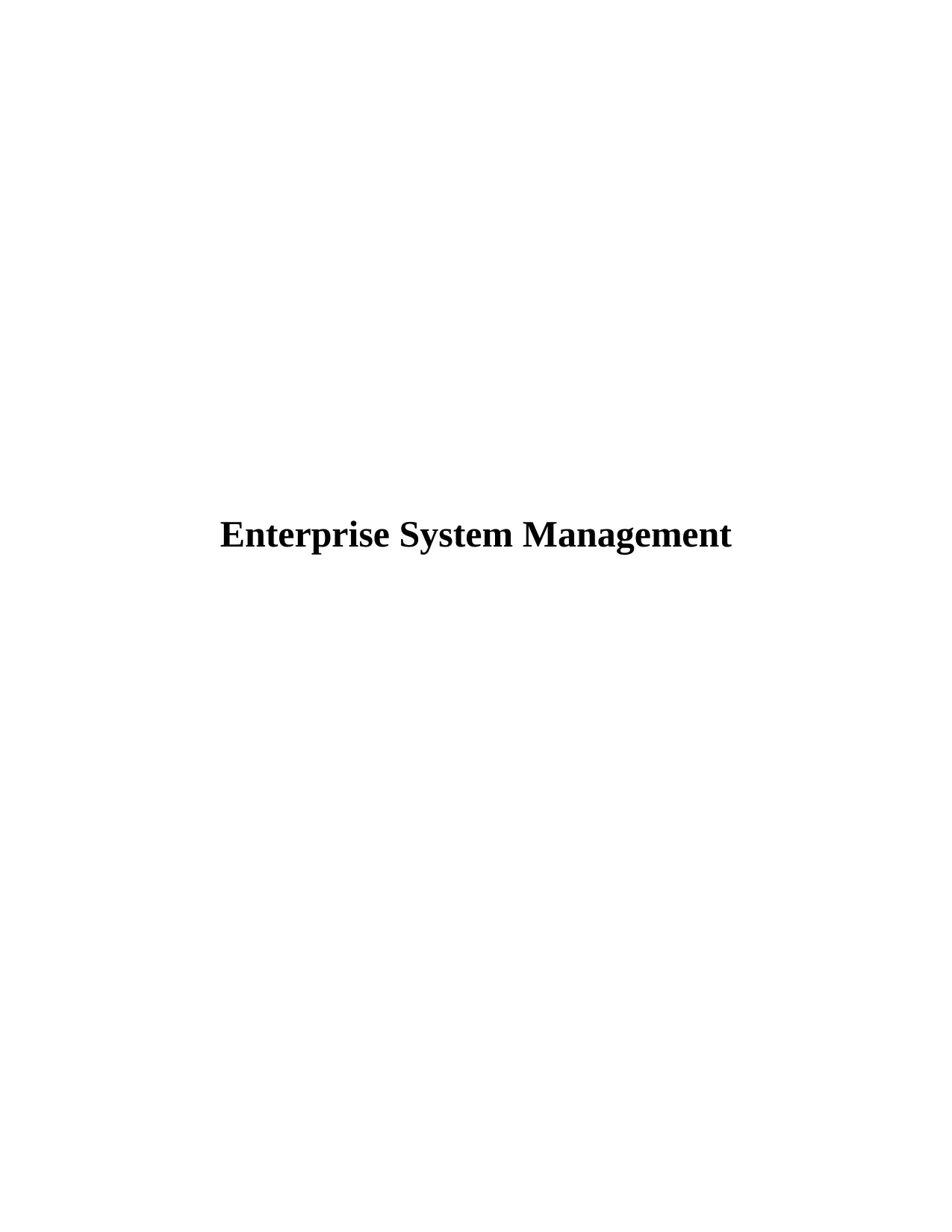
Enterprise System Management
Secure Best Marks with AI Grader
Need help grading? Try our AI Grader for instant feedback on your assignments.
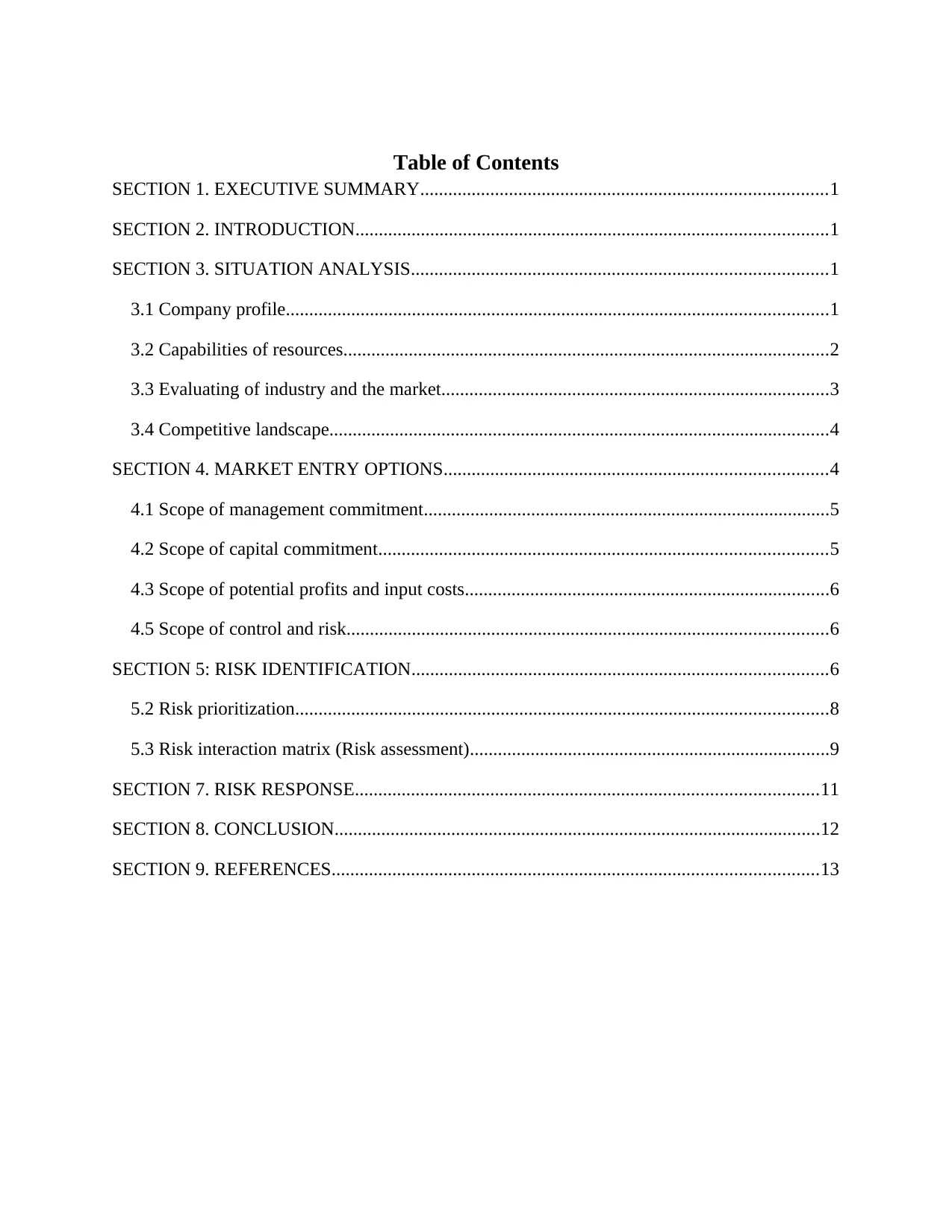
Table of Contents
SECTION 1. EXECUTIVE SUMMARY.......................................................................................1
SECTION 2. INTRODUCTION.....................................................................................................1
SECTION 3. SITUATION ANALYSIS.........................................................................................1
3.1 Company profile....................................................................................................................1
3.2 Capabilities of resources........................................................................................................2
3.3 Evaluating of industry and the market...................................................................................3
3.4 Competitive landscape...........................................................................................................4
SECTION 4. MARKET ENTRY OPTIONS..................................................................................4
4.1 Scope of management commitment.......................................................................................5
4.2 Scope of capital commitment................................................................................................5
4.3 Scope of potential profits and input costs..............................................................................6
4.5 Scope of control and risk.......................................................................................................6
SECTION 5: RISK IDENTIFICATION.........................................................................................6
5.2 Risk prioritization..................................................................................................................8
5.3 Risk interaction matrix (Risk assessment).............................................................................9
SECTION 7. RISK RESPONSE...................................................................................................11
SECTION 8. CONCLUSION........................................................................................................12
SECTION 9. REFERENCES........................................................................................................13
SECTION 1. EXECUTIVE SUMMARY.......................................................................................1
SECTION 2. INTRODUCTION.....................................................................................................1
SECTION 3. SITUATION ANALYSIS.........................................................................................1
3.1 Company profile....................................................................................................................1
3.2 Capabilities of resources........................................................................................................2
3.3 Evaluating of industry and the market...................................................................................3
3.4 Competitive landscape...........................................................................................................4
SECTION 4. MARKET ENTRY OPTIONS..................................................................................4
4.1 Scope of management commitment.......................................................................................5
4.2 Scope of capital commitment................................................................................................5
4.3 Scope of potential profits and input costs..............................................................................6
4.5 Scope of control and risk.......................................................................................................6
SECTION 5: RISK IDENTIFICATION.........................................................................................6
5.2 Risk prioritization..................................................................................................................8
5.3 Risk interaction matrix (Risk assessment).............................................................................9
SECTION 7. RISK RESPONSE...................................................................................................11
SECTION 8. CONCLUSION........................................................................................................12
SECTION 9. REFERENCES........................................................................................................13
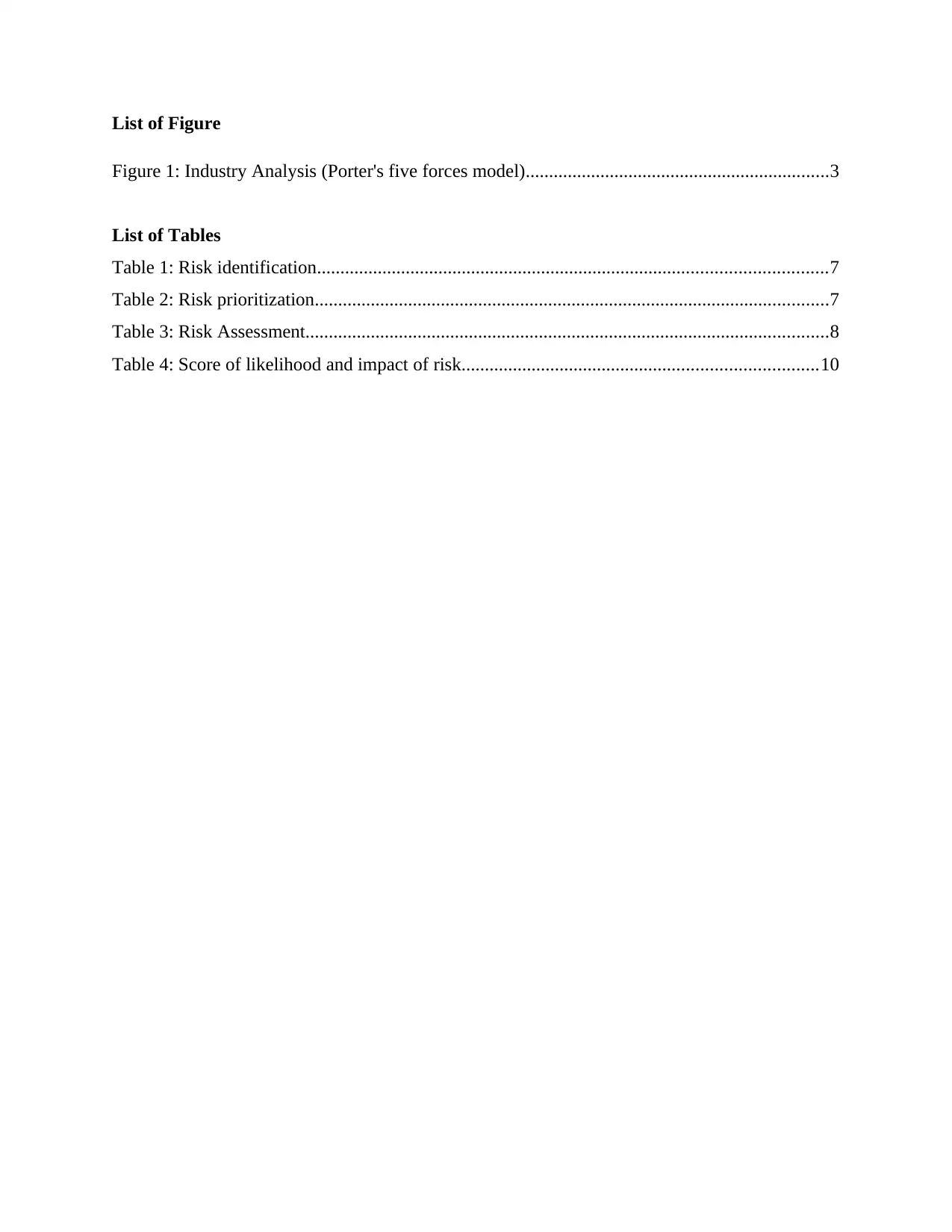
List of Figure
Figure 1: Industry Analysis (Porter's five forces model).................................................................3
List of Tables
Table 1: Risk identification.............................................................................................................7
Table 2: Risk prioritization..............................................................................................................7
Table 3: Risk Assessment................................................................................................................8
Table 4: Score of likelihood and impact of risk............................................................................10
Figure 1: Industry Analysis (Porter's five forces model).................................................................3
List of Tables
Table 1: Risk identification.............................................................................................................7
Table 2: Risk prioritization..............................................................................................................7
Table 3: Risk Assessment................................................................................................................8
Table 4: Score of likelihood and impact of risk............................................................................10
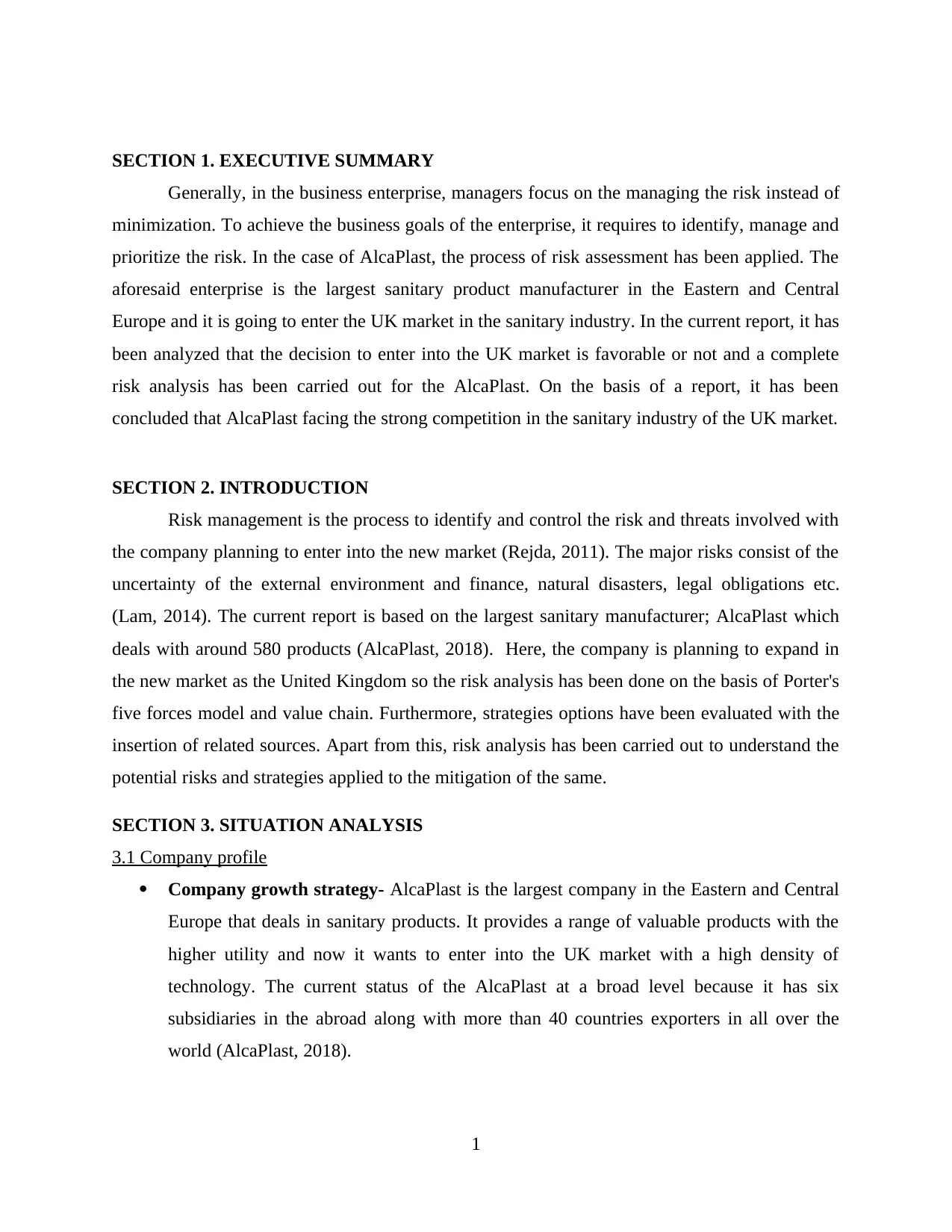
SECTION 1. EXECUTIVE SUMMARY
Generally, in the business enterprise, managers focus on the managing the risk instead of
minimization. To achieve the business goals of the enterprise, it requires to identify, manage and
prioritize the risk. In the case of AlcaPlast, the process of risk assessment has been applied. The
aforesaid enterprise is the largest sanitary product manufacturer in the Eastern and Central
Europe and it is going to enter the UK market in the sanitary industry. In the current report, it has
been analyzed that the decision to enter into the UK market is favorable or not and a complete
risk analysis has been carried out for the AlcaPlast. On the basis of a report, it has been
concluded that AlcaPlast facing the strong competition in the sanitary industry of the UK market.
SECTION 2. INTRODUCTION
Risk management is the process to identify and control the risk and threats involved with
the company planning to enter into the new market (Rejda, 2011). The major risks consist of the
uncertainty of the external environment and finance, natural disasters, legal obligations etc.
(Lam, 2014). The current report is based on the largest sanitary manufacturer; AlcaPlast which
deals with around 580 products (AlcaPlast, 2018). Here, the company is planning to expand in
the new market as the United Kingdom so the risk analysis has been done on the basis of Porter's
five forces model and value chain. Furthermore, strategies options have been evaluated with the
insertion of related sources. Apart from this, risk analysis has been carried out to understand the
potential risks and strategies applied to the mitigation of the same.
SECTION 3. SITUATION ANALYSIS
3.1 Company profile
Company growth strategy- AlcaPlast is the largest company in the Eastern and Central
Europe that deals in sanitary products. It provides a range of valuable products with the
higher utility and now it wants to enter into the UK market with a high density of
technology. The current status of the AlcaPlast at a broad level because it has six
subsidiaries in the abroad along with more than 40 countries exporters in all over the
world (AlcaPlast, 2018).
1
Generally, in the business enterprise, managers focus on the managing the risk instead of
minimization. To achieve the business goals of the enterprise, it requires to identify, manage and
prioritize the risk. In the case of AlcaPlast, the process of risk assessment has been applied. The
aforesaid enterprise is the largest sanitary product manufacturer in the Eastern and Central
Europe and it is going to enter the UK market in the sanitary industry. In the current report, it has
been analyzed that the decision to enter into the UK market is favorable or not and a complete
risk analysis has been carried out for the AlcaPlast. On the basis of a report, it has been
concluded that AlcaPlast facing the strong competition in the sanitary industry of the UK market.
SECTION 2. INTRODUCTION
Risk management is the process to identify and control the risk and threats involved with
the company planning to enter into the new market (Rejda, 2011). The major risks consist of the
uncertainty of the external environment and finance, natural disasters, legal obligations etc.
(Lam, 2014). The current report is based on the largest sanitary manufacturer; AlcaPlast which
deals with around 580 products (AlcaPlast, 2018). Here, the company is planning to expand in
the new market as the United Kingdom so the risk analysis has been done on the basis of Porter's
five forces model and value chain. Furthermore, strategies options have been evaluated with the
insertion of related sources. Apart from this, risk analysis has been carried out to understand the
potential risks and strategies applied to the mitigation of the same.
SECTION 3. SITUATION ANALYSIS
3.1 Company profile
Company growth strategy- AlcaPlast is the largest company in the Eastern and Central
Europe that deals in sanitary products. It provides a range of valuable products with the
higher utility and now it wants to enter into the UK market with a high density of
technology. The current status of the AlcaPlast at a broad level because it has six
subsidiaries in the abroad along with more than 40 countries exporters in all over the
world (AlcaPlast, 2018).
1
Secure Best Marks with AI Grader
Need help grading? Try our AI Grader for instant feedback on your assignments.
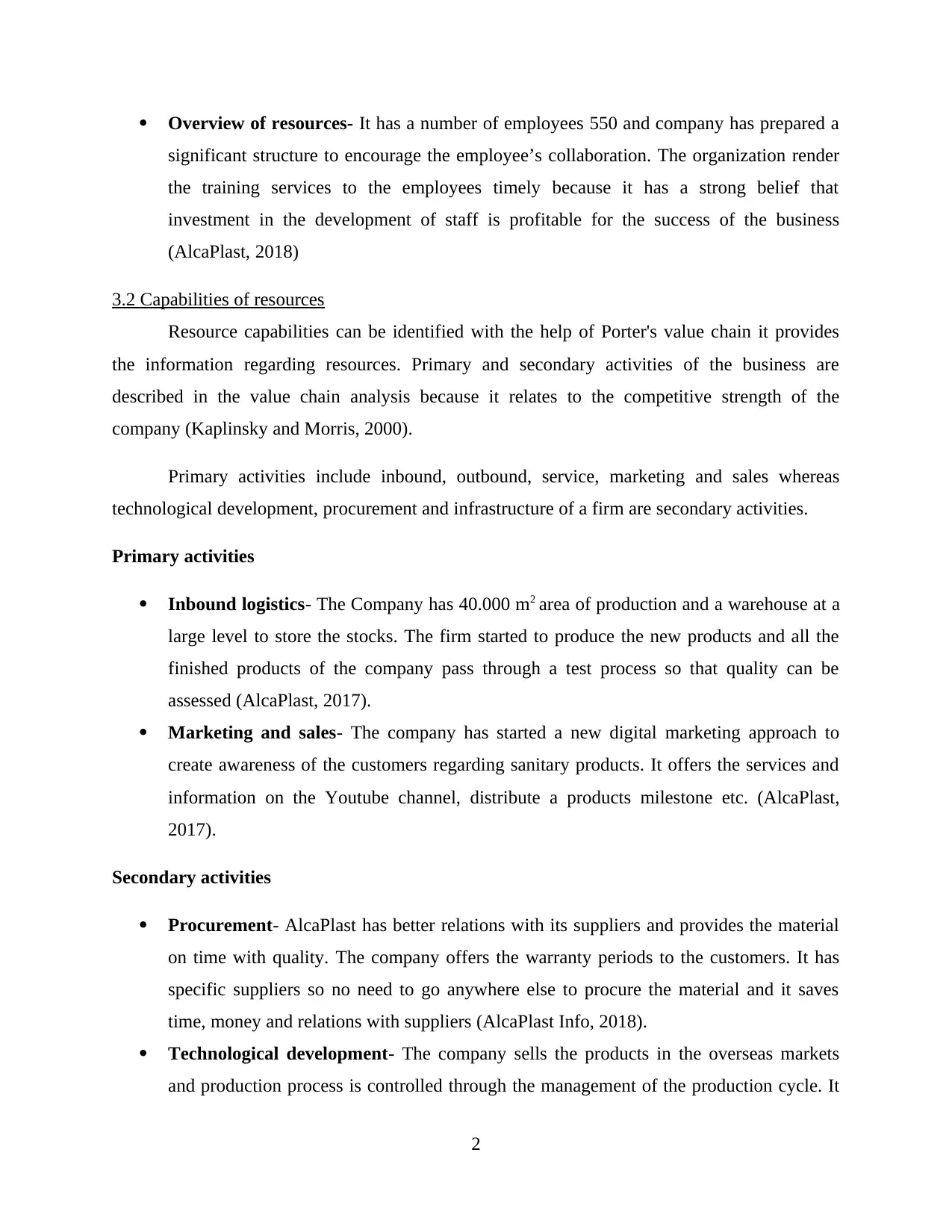
Overview of resources- It has a number of employees 550 and company has prepared a
significant structure to encourage the employee’s collaboration. The organization render
the training services to the employees timely because it has a strong belief that
investment in the development of staff is profitable for the success of the business
(AlcaPlast, 2018)
3.2 Capabilities of resources
Resource capabilities can be identified with the help of Porter's value chain it provides
the information regarding resources. Primary and secondary activities of the business are
described in the value chain analysis because it relates to the competitive strength of the
company (Kaplinsky and Morris, 2000).
Primary activities include inbound, outbound, service, marketing and sales whereas
technological development, procurement and infrastructure of a firm are secondary activities.
Primary activities
Inbound logistics- The Company has 40.000 m2 area of production and a warehouse at a
large level to store the stocks. The firm started to produce the new products and all the
finished products of the company pass through a test process so that quality can be
assessed (AlcaPlast, 2017).
Marketing and sales- The company has started a new digital marketing approach to
create awareness of the customers regarding sanitary products. It offers the services and
information on the Youtube channel, distribute a products milestone etc. (AlcaPlast,
2017).
Secondary activities
Procurement- AlcaPlast has better relations with its suppliers and provides the material
on time with quality. The company offers the warranty periods to the customers. It has
specific suppliers so no need to go anywhere else to procure the material and it saves
time, money and relations with suppliers (AlcaPlast Info, 2018).
Technological development- The company sells the products in the overseas markets
and production process is controlled through the management of the production cycle. It
2
significant structure to encourage the employee’s collaboration. The organization render
the training services to the employees timely because it has a strong belief that
investment in the development of staff is profitable for the success of the business
(AlcaPlast, 2018)
3.2 Capabilities of resources
Resource capabilities can be identified with the help of Porter's value chain it provides
the information regarding resources. Primary and secondary activities of the business are
described in the value chain analysis because it relates to the competitive strength of the
company (Kaplinsky and Morris, 2000).
Primary activities include inbound, outbound, service, marketing and sales whereas
technological development, procurement and infrastructure of a firm are secondary activities.
Primary activities
Inbound logistics- The Company has 40.000 m2 area of production and a warehouse at a
large level to store the stocks. The firm started to produce the new products and all the
finished products of the company pass through a test process so that quality can be
assessed (AlcaPlast, 2017).
Marketing and sales- The company has started a new digital marketing approach to
create awareness of the customers regarding sanitary products. It offers the services and
information on the Youtube channel, distribute a products milestone etc. (AlcaPlast,
2017).
Secondary activities
Procurement- AlcaPlast has better relations with its suppliers and provides the material
on time with quality. The company offers the warranty periods to the customers. It has
specific suppliers so no need to go anywhere else to procure the material and it saves
time, money and relations with suppliers (AlcaPlast Info, 2018).
Technological development- The company sells the products in the overseas markets
and production process is controlled through the management of the production cycle. It
2
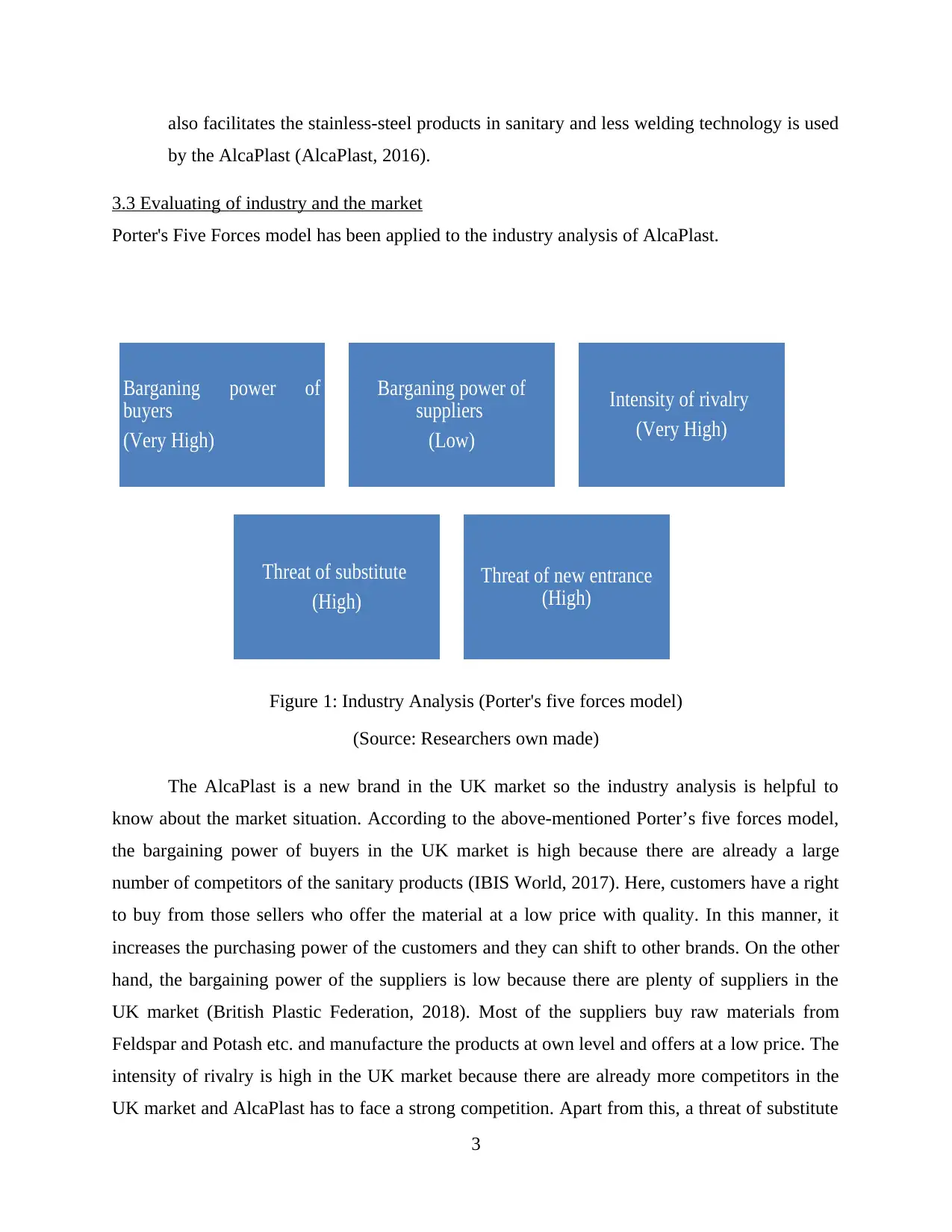
also facilitates the stainless-steel products in sanitary and less welding technology is used
by the AlcaPlast (AlcaPlast, 2016).
3.3 Evaluating of industry and the market
Porter's Five Forces model has been applied to the industry analysis of AlcaPlast.
Figure 1: Industry Analysis (Porter's five forces model)
(Source: Researchers own made)
The AlcaPlast is a new brand in the UK market so the industry analysis is helpful to
know about the market situation. According to the above-mentioned Porter’s five forces model,
the bargaining power of buyers in the UK market is high because there are already a large
number of competitors of the sanitary products (IBIS World, 2017). Here, customers have a right
to buy from those sellers who offer the material at a low price with quality. In this manner, it
increases the purchasing power of the customers and they can shift to other brands. On the other
hand, the bargaining power of the suppliers is low because there are plenty of suppliers in the
UK market (British Plastic Federation, 2018). Most of the suppliers buy raw materials from
Feldspar and Potash etc. and manufacture the products at own level and offers at a low price. The
intensity of rivalry is high in the UK market because there are already more competitors in the
UK market and AlcaPlast has to face a strong competition. Apart from this, a threat of substitute
3
Barganing power of
buyers
(Very High)
Barganing power of
suppliers
(Low)
Intensity of rivalry
(Very High)
Threat of substitute
(High)
Threat of new entrance
(High)
by the AlcaPlast (AlcaPlast, 2016).
3.3 Evaluating of industry and the market
Porter's Five Forces model has been applied to the industry analysis of AlcaPlast.
Figure 1: Industry Analysis (Porter's five forces model)
(Source: Researchers own made)
The AlcaPlast is a new brand in the UK market so the industry analysis is helpful to
know about the market situation. According to the above-mentioned Porter’s five forces model,
the bargaining power of buyers in the UK market is high because there are already a large
number of competitors of the sanitary products (IBIS World, 2017). Here, customers have a right
to buy from those sellers who offer the material at a low price with quality. In this manner, it
increases the purchasing power of the customers and they can shift to other brands. On the other
hand, the bargaining power of the suppliers is low because there are plenty of suppliers in the
UK market (British Plastic Federation, 2018). Most of the suppliers buy raw materials from
Feldspar and Potash etc. and manufacture the products at own level and offers at a low price. The
intensity of rivalry is high in the UK market because there are already more competitors in the
UK market and AlcaPlast has to face a strong competition. Apart from this, a threat of substitute
3
Barganing power of
buyers
(Very High)
Barganing power of
suppliers
(Low)
Intensity of rivalry
(Very High)
Threat of substitute
(High)
Threat of new entrance
(High)
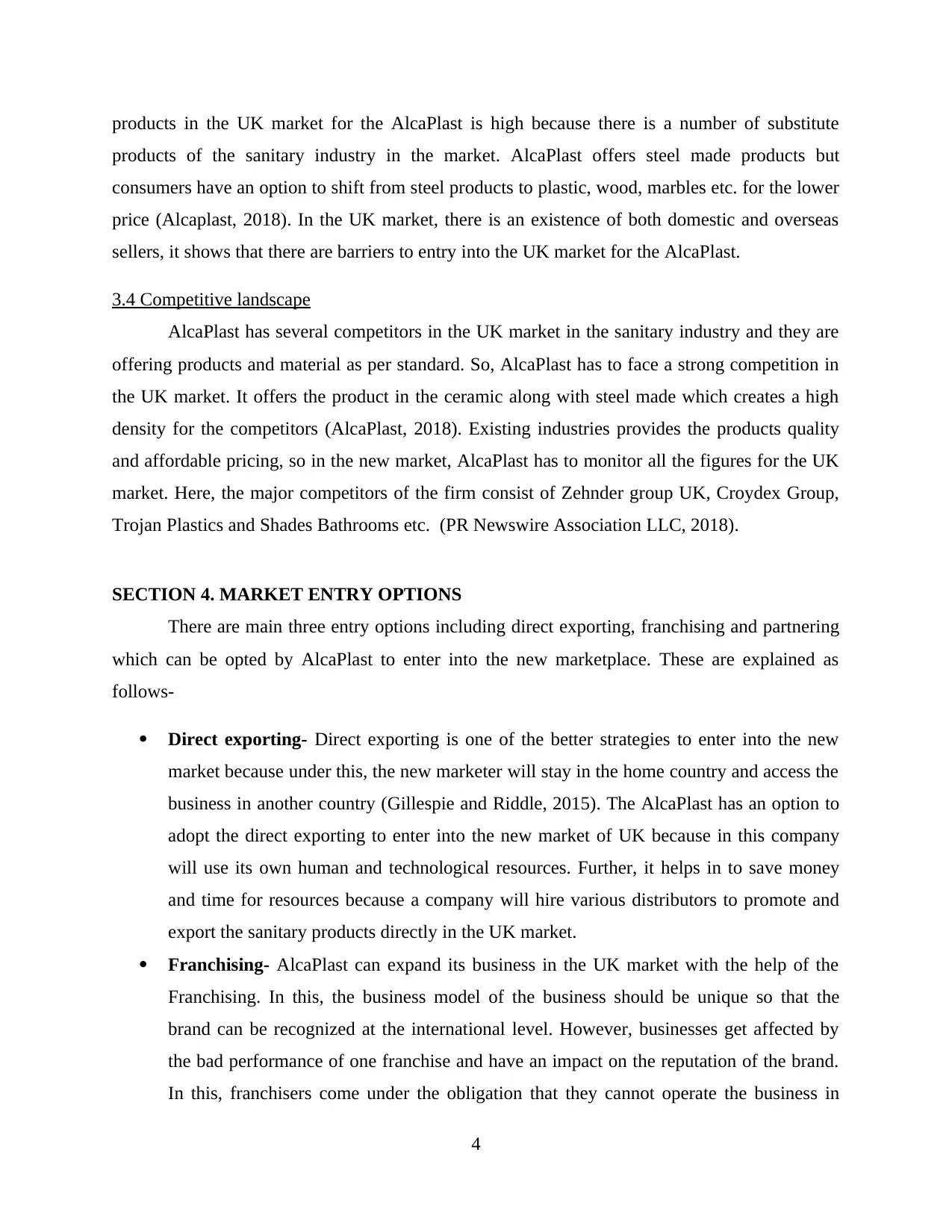
products in the UK market for the AlcaPlast is high because there is a number of substitute
products of the sanitary industry in the market. AlcaPlast offers steel made products but
consumers have an option to shift from steel products to plastic, wood, marbles etc. for the lower
price (Alcaplast, 2018). In the UK market, there is an existence of both domestic and overseas
sellers, it shows that there are barriers to entry into the UK market for the AlcaPlast.
3.4 Competitive landscape
AlcaPlast has several competitors in the UK market in the sanitary industry and they are
offering products and material as per standard. So, AlcaPlast has to face a strong competition in
the UK market. It offers the product in the ceramic along with steel made which creates a high
density for the competitors (AlcaPlast, 2018). Existing industries provides the products quality
and affordable pricing, so in the new market, AlcaPlast has to monitor all the figures for the UK
market. Here, the major competitors of the firm consist of Zehnder group UK, Croydex Group,
Trojan Plastics and Shades Bathrooms etc. (PR Newswire Association LLC, 2018).
SECTION 4. MARKET ENTRY OPTIONS
There are main three entry options including direct exporting, franchising and partnering
which can be opted by AlcaPlast to enter into the new marketplace. These are explained as
follows-
Direct exporting- Direct exporting is one of the better strategies to enter into the new
market because under this, the new marketer will stay in the home country and access the
business in another country (Gillespie and Riddle, 2015). The AlcaPlast has an option to
adopt the direct exporting to enter into the new market of UK because in this company
will use its own human and technological resources. Further, it helps in to save money
and time for resources because a company will hire various distributors to promote and
export the sanitary products directly in the UK market.
Franchising- AlcaPlast can expand its business in the UK market with the help of the
Franchising. In this, the business model of the business should be unique so that the
brand can be recognized at the international level. However, businesses get affected by
the bad performance of one franchise and have an impact on the reputation of the brand.
In this, franchisers come under the obligation that they cannot operate the business in
4
products of the sanitary industry in the market. AlcaPlast offers steel made products but
consumers have an option to shift from steel products to plastic, wood, marbles etc. for the lower
price (Alcaplast, 2018). In the UK market, there is an existence of both domestic and overseas
sellers, it shows that there are barriers to entry into the UK market for the AlcaPlast.
3.4 Competitive landscape
AlcaPlast has several competitors in the UK market in the sanitary industry and they are
offering products and material as per standard. So, AlcaPlast has to face a strong competition in
the UK market. It offers the product in the ceramic along with steel made which creates a high
density for the competitors (AlcaPlast, 2018). Existing industries provides the products quality
and affordable pricing, so in the new market, AlcaPlast has to monitor all the figures for the UK
market. Here, the major competitors of the firm consist of Zehnder group UK, Croydex Group,
Trojan Plastics and Shades Bathrooms etc. (PR Newswire Association LLC, 2018).
SECTION 4. MARKET ENTRY OPTIONS
There are main three entry options including direct exporting, franchising and partnering
which can be opted by AlcaPlast to enter into the new marketplace. These are explained as
follows-
Direct exporting- Direct exporting is one of the better strategies to enter into the new
market because under this, the new marketer will stay in the home country and access the
business in another country (Gillespie and Riddle, 2015). The AlcaPlast has an option to
adopt the direct exporting to enter into the new market of UK because in this company
will use its own human and technological resources. Further, it helps in to save money
and time for resources because a company will hire various distributors to promote and
export the sanitary products directly in the UK market.
Franchising- AlcaPlast can expand its business in the UK market with the help of the
Franchising. In this, the business model of the business should be unique so that the
brand can be recognized at the international level. However, businesses get affected by
the bad performance of one franchise and have an impact on the reputation of the brand.
In this, franchisers come under the obligation that they cannot operate the business in
4
Paraphrase This Document
Need a fresh take? Get an instant paraphrase of this document with our AI Paraphraser
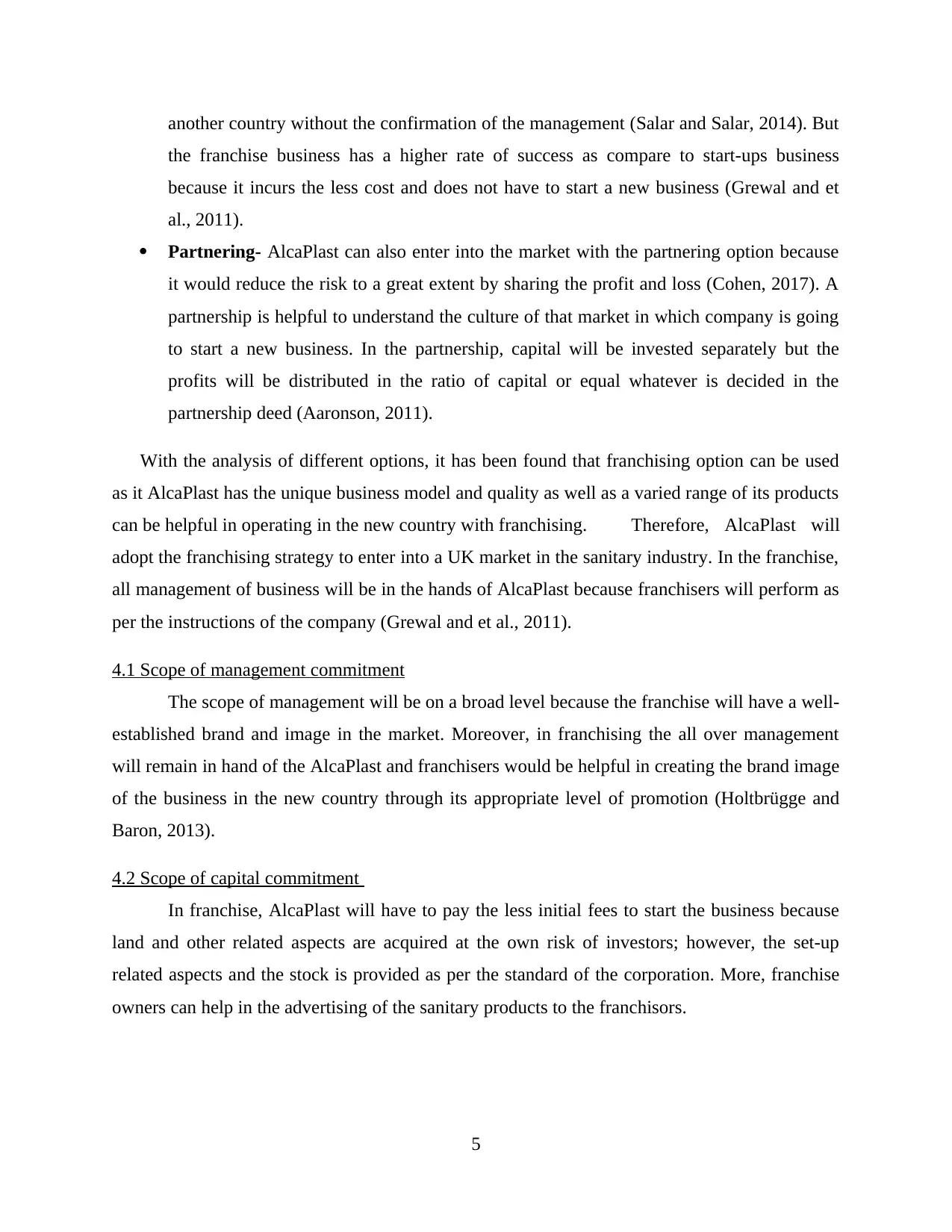
another country without the confirmation of the management (Salar and Salar, 2014). But
the franchise business has a higher rate of success as compare to start-ups business
because it incurs the less cost and does not have to start a new business (Grewal and et
al., 2011).
Partnering- AlcaPlast can also enter into the market with the partnering option because
it would reduce the risk to a great extent by sharing the profit and loss (Cohen, 2017). A
partnership is helpful to understand the culture of that market in which company is going
to start a new business. In the partnership, capital will be invested separately but the
profits will be distributed in the ratio of capital or equal whatever is decided in the
partnership deed (Aaronson, 2011).
With the analysis of different options, it has been found that franchising option can be used
as it AlcaPlast has the unique business model and quality as well as a varied range of its products
can be helpful in operating in the new country with franchising. Therefore, AlcaPlast will
adopt the franchising strategy to enter into a UK market in the sanitary industry. In the franchise,
all management of business will be in the hands of AlcaPlast because franchisers will perform as
per the instructions of the company (Grewal and et al., 2011).
4.1 Scope of management commitment
The scope of management will be on a broad level because the franchise will have a well-
established brand and image in the market. Moreover, in franchising the all over management
will remain in hand of the AlcaPlast and franchisers would be helpful in creating the brand image
of the business in the new country through its appropriate level of promotion (Holtbrügge and
Baron, 2013).
4.2 Scope of capital commitment
In franchise, AlcaPlast will have to pay the less initial fees to start the business because
land and other related aspects are acquired at the own risk of investors; however, the set-up
related aspects and the stock is provided as per the standard of the corporation. More, franchise
owners can help in the advertising of the sanitary products to the franchisors.
5
the franchise business has a higher rate of success as compare to start-ups business
because it incurs the less cost and does not have to start a new business (Grewal and et
al., 2011).
Partnering- AlcaPlast can also enter into the market with the partnering option because
it would reduce the risk to a great extent by sharing the profit and loss (Cohen, 2017). A
partnership is helpful to understand the culture of that market in which company is going
to start a new business. In the partnership, capital will be invested separately but the
profits will be distributed in the ratio of capital or equal whatever is decided in the
partnership deed (Aaronson, 2011).
With the analysis of different options, it has been found that franchising option can be used
as it AlcaPlast has the unique business model and quality as well as a varied range of its products
can be helpful in operating in the new country with franchising. Therefore, AlcaPlast will
adopt the franchising strategy to enter into a UK market in the sanitary industry. In the franchise,
all management of business will be in the hands of AlcaPlast because franchisers will perform as
per the instructions of the company (Grewal and et al., 2011).
4.1 Scope of management commitment
The scope of management will be on a broad level because the franchise will have a well-
established brand and image in the market. Moreover, in franchising the all over management
will remain in hand of the AlcaPlast and franchisers would be helpful in creating the brand image
of the business in the new country through its appropriate level of promotion (Holtbrügge and
Baron, 2013).
4.2 Scope of capital commitment
In franchise, AlcaPlast will have to pay the less initial fees to start the business because
land and other related aspects are acquired at the own risk of investors; however, the set-up
related aspects and the stock is provided as per the standard of the corporation. More, franchise
owners can help in the advertising of the sanitary products to the franchisors.
5
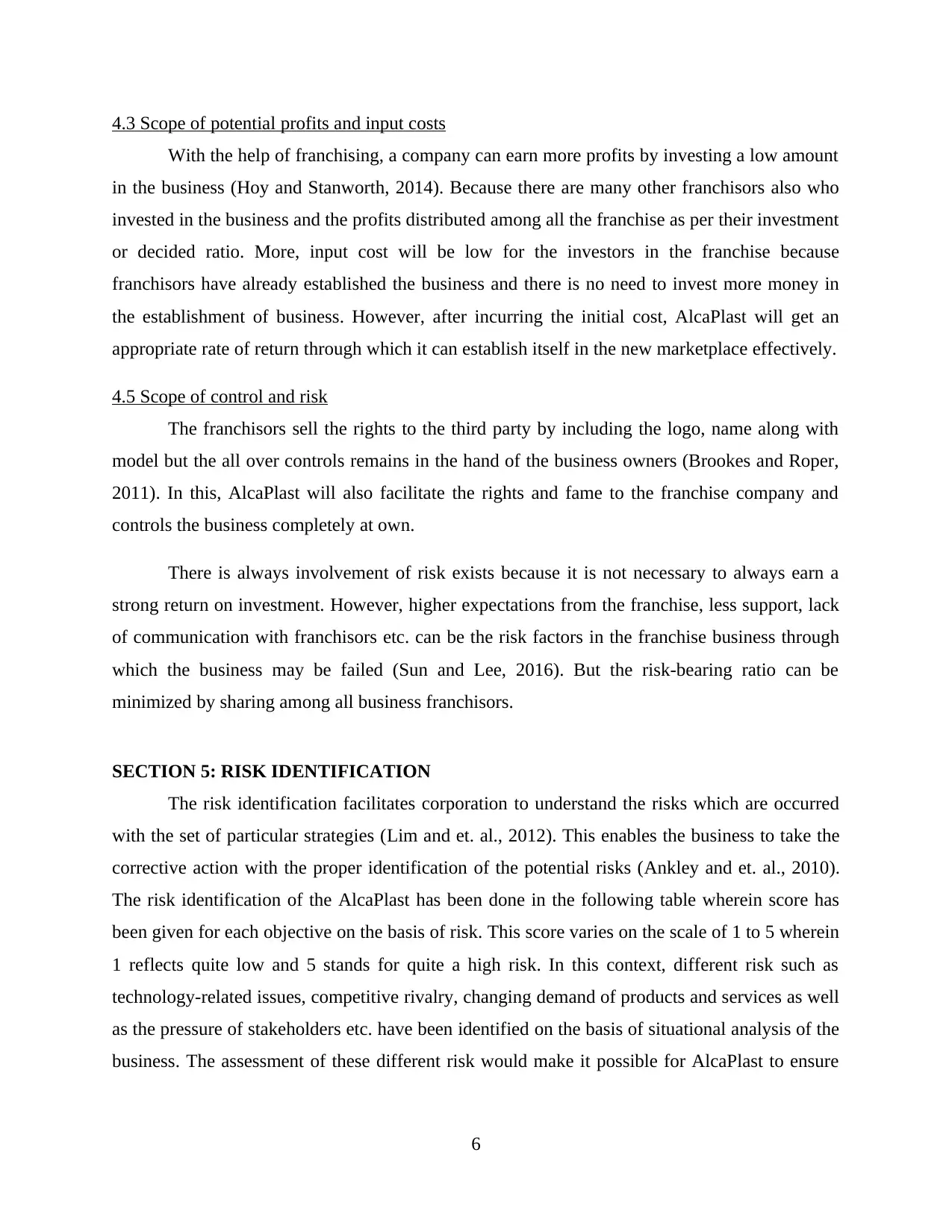
4.3 Scope of potential profits and input costs
With the help of franchising, a company can earn more profits by investing a low amount
in the business (Hoy and Stanworth, 2014). Because there are many other franchisors also who
invested in the business and the profits distributed among all the franchise as per their investment
or decided ratio. More, input cost will be low for the investors in the franchise because
franchisors have already established the business and there is no need to invest more money in
the establishment of business. However, after incurring the initial cost, AlcaPlast will get an
appropriate rate of return through which it can establish itself in the new marketplace effectively.
4.5 Scope of control and risk
The franchisors sell the rights to the third party by including the logo, name along with
model but the all over controls remains in the hand of the business owners (Brookes and Roper,
2011). In this, AlcaPlast will also facilitate the rights and fame to the franchise company and
controls the business completely at own.
There is always involvement of risk exists because it is not necessary to always earn a
strong return on investment. However, higher expectations from the franchise, less support, lack
of communication with franchisors etc. can be the risk factors in the franchise business through
which the business may be failed (Sun and Lee, 2016). But the risk-bearing ratio can be
minimized by sharing among all business franchisors.
SECTION 5: RISK IDENTIFICATION
The risk identification facilitates corporation to understand the risks which are occurred
with the set of particular strategies (Lim and et. al., 2012). This enables the business to take the
corrective action with the proper identification of the potential risks (Ankley and et. al., 2010).
The risk identification of the AlcaPlast has been done in the following table wherein score has
been given for each objective on the basis of risk. This score varies on the scale of 1 to 5 wherein
1 reflects quite low and 5 stands for quite a high risk. In this context, different risk such as
technology-related issues, competitive rivalry, changing demand of products and services as well
as the pressure of stakeholders etc. have been identified on the basis of situational analysis of the
business. The assessment of these different risk would make it possible for AlcaPlast to ensure
6
With the help of franchising, a company can earn more profits by investing a low amount
in the business (Hoy and Stanworth, 2014). Because there are many other franchisors also who
invested in the business and the profits distributed among all the franchise as per their investment
or decided ratio. More, input cost will be low for the investors in the franchise because
franchisors have already established the business and there is no need to invest more money in
the establishment of business. However, after incurring the initial cost, AlcaPlast will get an
appropriate rate of return through which it can establish itself in the new marketplace effectively.
4.5 Scope of control and risk
The franchisors sell the rights to the third party by including the logo, name along with
model but the all over controls remains in the hand of the business owners (Brookes and Roper,
2011). In this, AlcaPlast will also facilitate the rights and fame to the franchise company and
controls the business completely at own.
There is always involvement of risk exists because it is not necessary to always earn a
strong return on investment. However, higher expectations from the franchise, less support, lack
of communication with franchisors etc. can be the risk factors in the franchise business through
which the business may be failed (Sun and Lee, 2016). But the risk-bearing ratio can be
minimized by sharing among all business franchisors.
SECTION 5: RISK IDENTIFICATION
The risk identification facilitates corporation to understand the risks which are occurred
with the set of particular strategies (Lim and et. al., 2012). This enables the business to take the
corrective action with the proper identification of the potential risks (Ankley and et. al., 2010).
The risk identification of the AlcaPlast has been done in the following table wherein score has
been given for each objective on the basis of risk. This score varies on the scale of 1 to 5 wherein
1 reflects quite low and 5 stands for quite a high risk. In this context, different risk such as
technology-related issues, competitive rivalry, changing demand of products and services as well
as the pressure of stakeholders etc. have been identified on the basis of situational analysis of the
business. The assessment of these different risk would make it possible for AlcaPlast to ensure
6
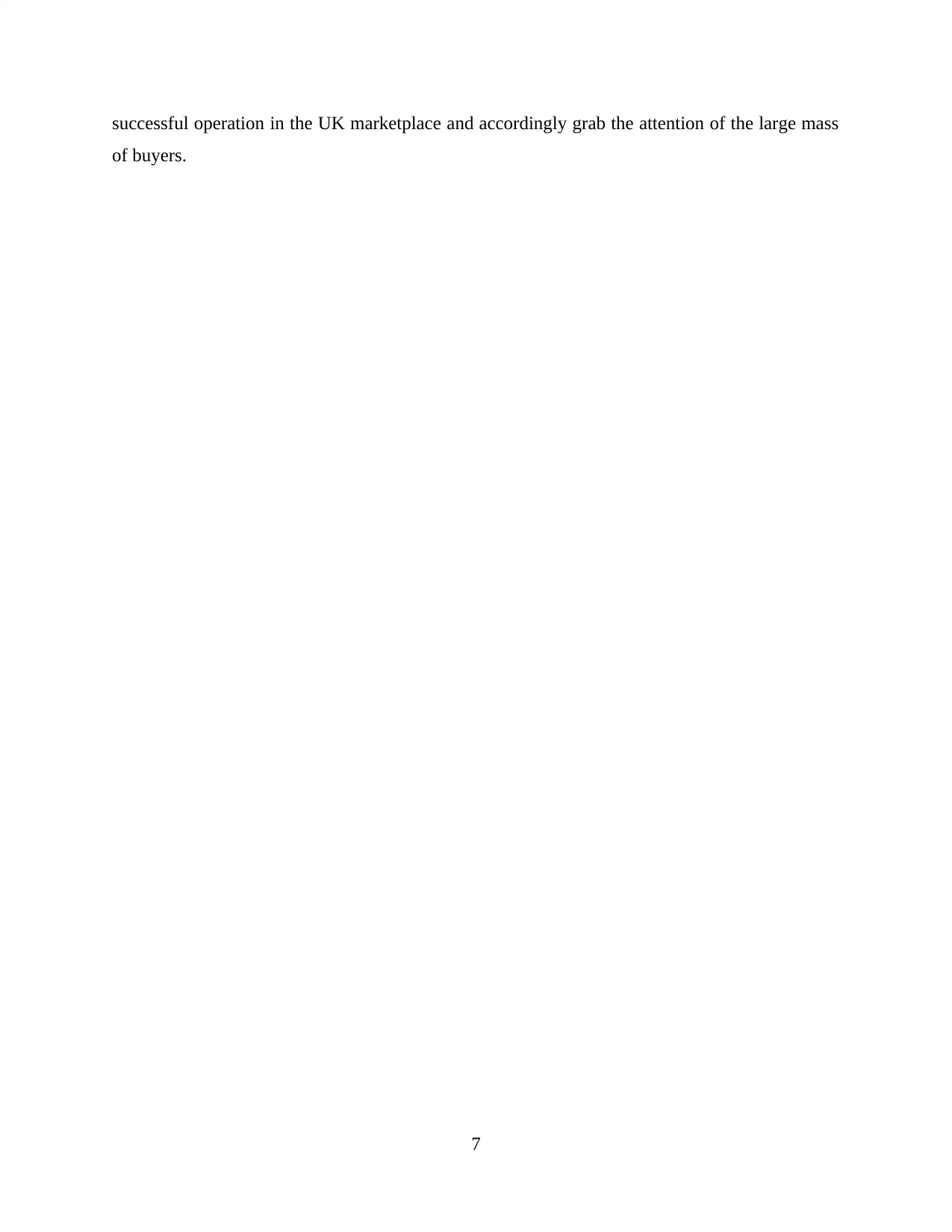
successful operation in the UK marketplace and accordingly grab the attention of the large mass
of buyers.
7
of buyers.
7
Secure Best Marks with AI Grader
Need help grading? Try our AI Grader for instant feedback on your assignments.
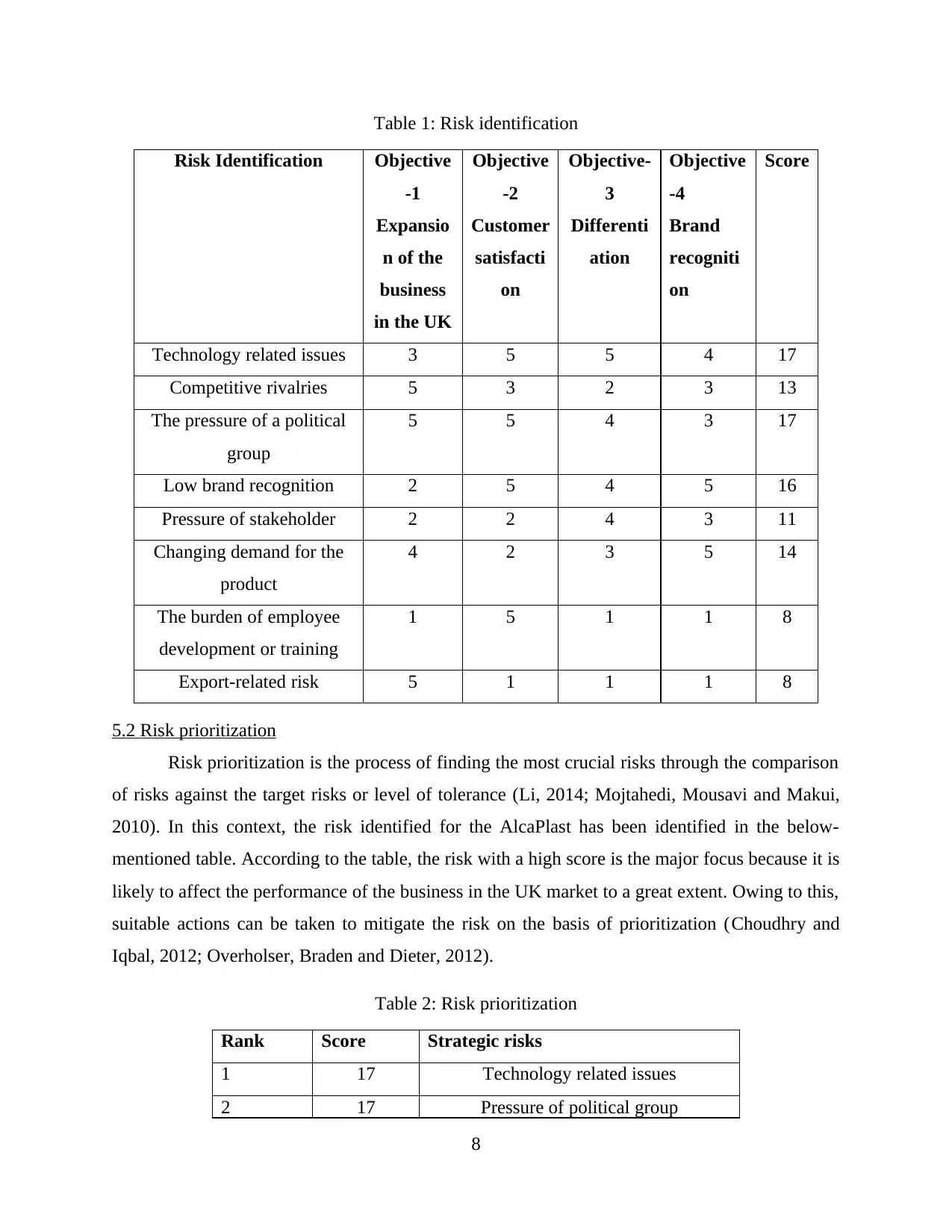
Table 1: Risk identification
Risk Identification Objective
-1
Expansio
n of the
business
in the UK
Objective
-2
Customer
satisfacti
on
Objective-
3
Differenti
ation
Objective
-4
Brand
recogniti
on
Score
Technology related issues 3 5 5 4 17
Competitive rivalries 5 3 2 3 13
The pressure of a political
group
5 5 4 3 17
Low brand recognition 2 5 4 5 16
Pressure of stakeholder 2 2 4 3 11
Changing demand for the
product
4 2 3 5 14
The burden of employee
development or training
1 5 1 1 8
Export-related risk 5 1 1 1 8
5.2 Risk prioritization
Risk prioritization is the process of finding the most crucial risks through the comparison
of risks against the target risks or level of tolerance (Li, 2014; Mojtahedi, Mousavi and Makui,
2010). In this context, the risk identified for the AlcaPlast has been identified in the below-
mentioned table. According to the table, the risk with a high score is the major focus because it is
likely to affect the performance of the business in the UK market to a great extent. Owing to this,
suitable actions can be taken to mitigate the risk on the basis of prioritization (Choudhry and
Iqbal, 2012; Overholser, Braden and Dieter, 2012).
Table 2: Risk prioritization
Rank Score Strategic risks
1 17 Technology related issues
2 17 Pressure of political group
8
Risk Identification Objective
-1
Expansio
n of the
business
in the UK
Objective
-2
Customer
satisfacti
on
Objective-
3
Differenti
ation
Objective
-4
Brand
recogniti
on
Score
Technology related issues 3 5 5 4 17
Competitive rivalries 5 3 2 3 13
The pressure of a political
group
5 5 4 3 17
Low brand recognition 2 5 4 5 16
Pressure of stakeholder 2 2 4 3 11
Changing demand for the
product
4 2 3 5 14
The burden of employee
development or training
1 5 1 1 8
Export-related risk 5 1 1 1 8
5.2 Risk prioritization
Risk prioritization is the process of finding the most crucial risks through the comparison
of risks against the target risks or level of tolerance (Li, 2014; Mojtahedi, Mousavi and Makui,
2010). In this context, the risk identified for the AlcaPlast has been identified in the below-
mentioned table. According to the table, the risk with a high score is the major focus because it is
likely to affect the performance of the business in the UK market to a great extent. Owing to this,
suitable actions can be taken to mitigate the risk on the basis of prioritization (Choudhry and
Iqbal, 2012; Overholser, Braden and Dieter, 2012).
Table 2: Risk prioritization
Rank Score Strategic risks
1 17 Technology related issues
2 17 Pressure of political group
8
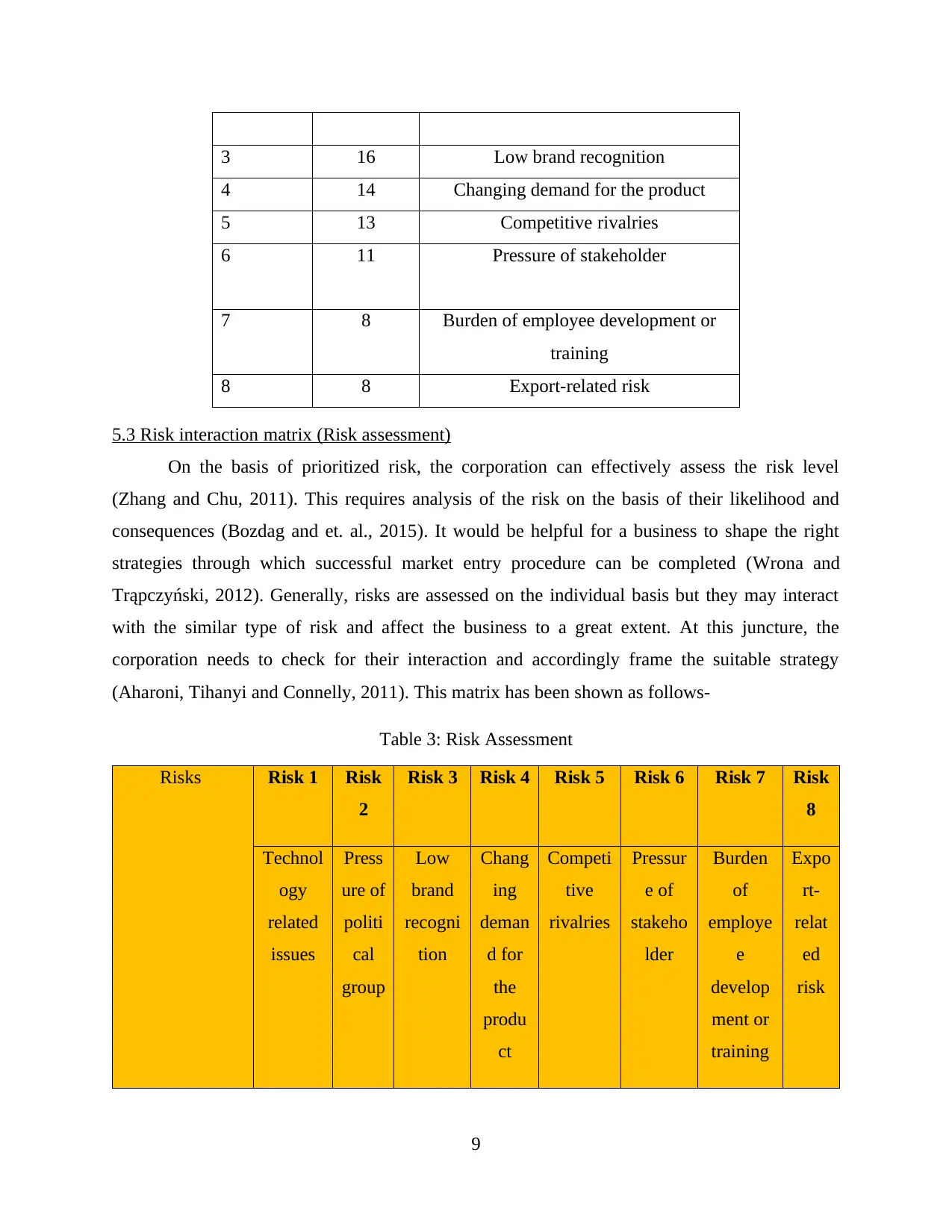
3 16 Low brand recognition
4 14 Changing demand for the product
5 13 Competitive rivalries
6 11 Pressure of stakeholder
7 8 Burden of employee development or
training
8 8 Export-related risk
5.3 Risk interaction matrix (Risk assessment)
On the basis of prioritized risk, the corporation can effectively assess the risk level
(Zhang and Chu, 2011). This requires analysis of the risk on the basis of their likelihood and
consequences (Bozdag and et. al., 2015). It would be helpful for a business to shape the right
strategies through which successful market entry procedure can be completed (Wrona and
Trąpczyński, 2012). Generally, risks are assessed on the individual basis but they may interact
with the similar type of risk and affect the business to a great extent. At this juncture, the
corporation needs to check for their interaction and accordingly frame the suitable strategy
(Aharoni, Tihanyi and Connelly, 2011). This matrix has been shown as follows-
Table 3: Risk Assessment
Risks Risk 1 Risk
2
Risk 3 Risk 4 Risk 5 Risk 6 Risk 7 Risk
8
Technol
ogy
related
issues
Press
ure of
politi
cal
group
Low
brand
recogni
tion
Chang
ing
deman
d for
the
produ
ct
Competi
tive
rivalries
Pressur
e of
stakeho
lder
Burden
of
employe
e
develop
ment or
training
Expo
rt-
relat
ed
risk
9
4 14 Changing demand for the product
5 13 Competitive rivalries
6 11 Pressure of stakeholder
7 8 Burden of employee development or
training
8 8 Export-related risk
5.3 Risk interaction matrix (Risk assessment)
On the basis of prioritized risk, the corporation can effectively assess the risk level
(Zhang and Chu, 2011). This requires analysis of the risk on the basis of their likelihood and
consequences (Bozdag and et. al., 2015). It would be helpful for a business to shape the right
strategies through which successful market entry procedure can be completed (Wrona and
Trąpczyński, 2012). Generally, risks are assessed on the individual basis but they may interact
with the similar type of risk and affect the business to a great extent. At this juncture, the
corporation needs to check for their interaction and accordingly frame the suitable strategy
(Aharoni, Tihanyi and Connelly, 2011). This matrix has been shown as follows-
Table 3: Risk Assessment
Risks Risk 1 Risk
2
Risk 3 Risk 4 Risk 5 Risk 6 Risk 7 Risk
8
Technol
ogy
related
issues
Press
ure of
politi
cal
group
Low
brand
recogni
tion
Chang
ing
deman
d for
the
produ
ct
Competi
tive
rivalries
Pressur
e of
stakeho
lder
Burden
of
employe
e
develop
ment or
training
Expo
rt-
relat
ed
risk
9
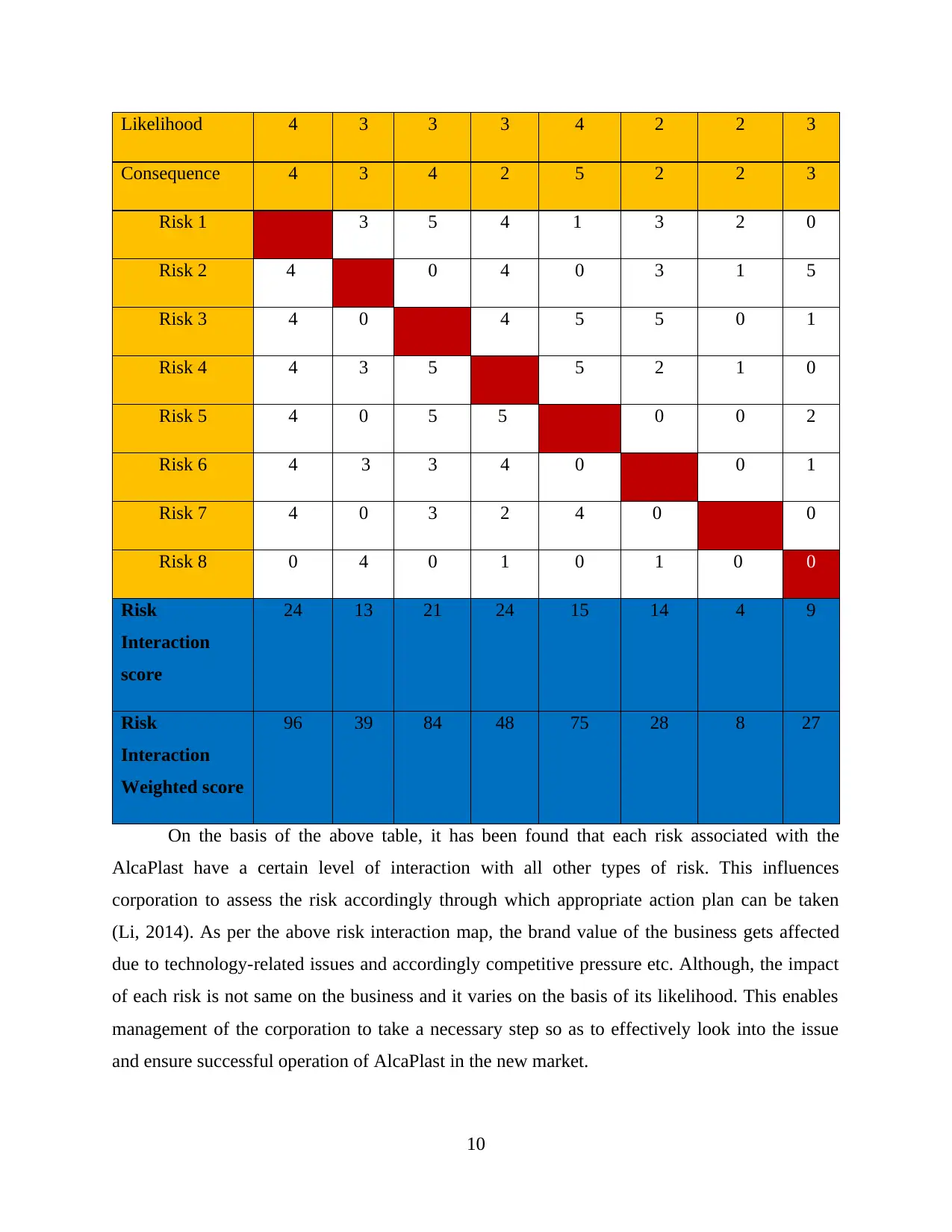
Likelihood 4 3 3 3 4 2 2 3
Consequence 4 3 4 2 5 2 2 3
Risk 1 3 5 4 1 3 2 0
Risk 2 4 0 4 0 3 1 5
Risk 3 4 0 4 5 5 0 1
Risk 4 4 3 5 5 2 1 0
Risk 5 4 0 5 5 0 0 2
Risk 6 4 3 3 4 0 0 1
Risk 7 4 0 3 2 4 0 0
Risk 8 0 4 0 1 0 1 0 0
Risk
Interaction
score
24 13 21 24 15 14 4 9
Risk
Interaction
Weighted score
96 39 84 48 75 28 8 27
On the basis of the above table, it has been found that each risk associated with the
AlcaPlast have a certain level of interaction with all other types of risk. This influences
corporation to assess the risk accordingly through which appropriate action plan can be taken
(Li, 2014). As per the above risk interaction map, the brand value of the business gets affected
due to technology-related issues and accordingly competitive pressure etc. Although, the impact
of each risk is not same on the business and it varies on the basis of its likelihood. This enables
management of the corporation to take a necessary step so as to effectively look into the issue
and ensure successful operation of AlcaPlast in the new market.
10
Consequence 4 3 4 2 5 2 2 3
Risk 1 3 5 4 1 3 2 0
Risk 2 4 0 4 0 3 1 5
Risk 3 4 0 4 5 5 0 1
Risk 4 4 3 5 5 2 1 0
Risk 5 4 0 5 5 0 0 2
Risk 6 4 3 3 4 0 0 1
Risk 7 4 0 3 2 4 0 0
Risk 8 0 4 0 1 0 1 0 0
Risk
Interaction
score
24 13 21 24 15 14 4 9
Risk
Interaction
Weighted score
96 39 84 48 75 28 8 27
On the basis of the above table, it has been found that each risk associated with the
AlcaPlast have a certain level of interaction with all other types of risk. This influences
corporation to assess the risk accordingly through which appropriate action plan can be taken
(Li, 2014). As per the above risk interaction map, the brand value of the business gets affected
due to technology-related issues and accordingly competitive pressure etc. Although, the impact
of each risk is not same on the business and it varies on the basis of its likelihood. This enables
management of the corporation to take a necessary step so as to effectively look into the issue
and ensure successful operation of AlcaPlast in the new market.
10
Paraphrase This Document
Need a fresh take? Get an instant paraphrase of this document with our AI Paraphraser
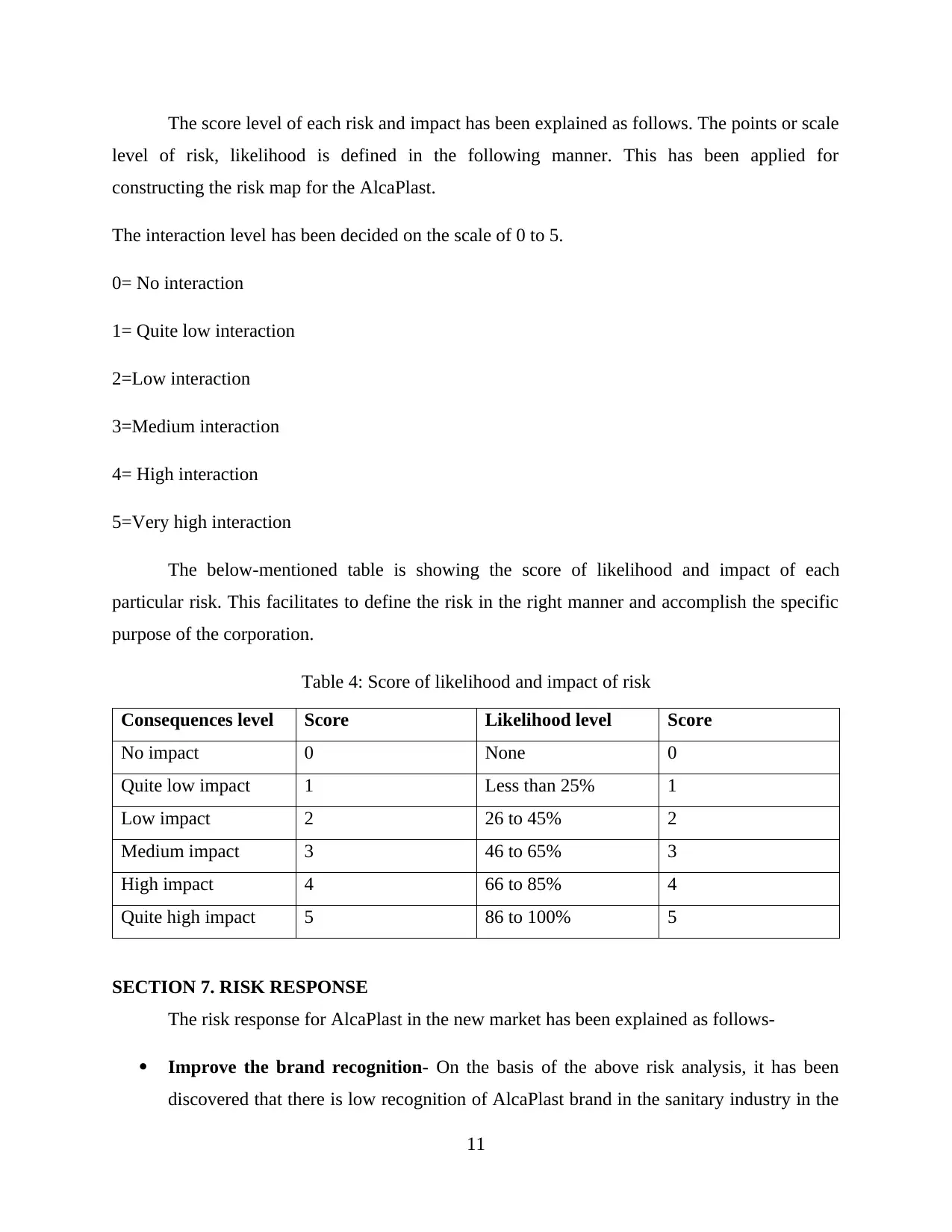
The score level of each risk and impact has been explained as follows. The points or scale
level of risk, likelihood is defined in the following manner. This has been applied for
constructing the risk map for the AlcaPlast.
The interaction level has been decided on the scale of 0 to 5.
0= No interaction
1= Quite low interaction
2=Low interaction
3=Medium interaction
4= High interaction
5=Very high interaction
The below-mentioned table is showing the score of likelihood and impact of each
particular risk. This facilitates to define the risk in the right manner and accomplish the specific
purpose of the corporation.
Table 4: Score of likelihood and impact of risk
Consequences level Score Likelihood level Score
No impact 0 None 0
Quite low impact 1 Less than 25% 1
Low impact 2 26 to 45% 2
Medium impact 3 46 to 65% 3
High impact 4 66 to 85% 4
Quite high impact 5 86 to 100% 5
SECTION 7. RISK RESPONSE
The risk response for AlcaPlast in the new market has been explained as follows-
Improve the brand recognition- On the basis of the above risk analysis, it has been
discovered that there is low recognition of AlcaPlast brand in the sanitary industry in the
11
level of risk, likelihood is defined in the following manner. This has been applied for
constructing the risk map for the AlcaPlast.
The interaction level has been decided on the scale of 0 to 5.
0= No interaction
1= Quite low interaction
2=Low interaction
3=Medium interaction
4= High interaction
5=Very high interaction
The below-mentioned table is showing the score of likelihood and impact of each
particular risk. This facilitates to define the risk in the right manner and accomplish the specific
purpose of the corporation.
Table 4: Score of likelihood and impact of risk
Consequences level Score Likelihood level Score
No impact 0 None 0
Quite low impact 1 Less than 25% 1
Low impact 2 26 to 45% 2
Medium impact 3 46 to 65% 3
High impact 4 66 to 85% 4
Quite high impact 5 86 to 100% 5
SECTION 7. RISK RESPONSE
The risk response for AlcaPlast in the new market has been explained as follows-
Improve the brand recognition- On the basis of the above risk analysis, it has been
discovered that there is low recognition of AlcaPlast brand in the sanitary industry in the
11
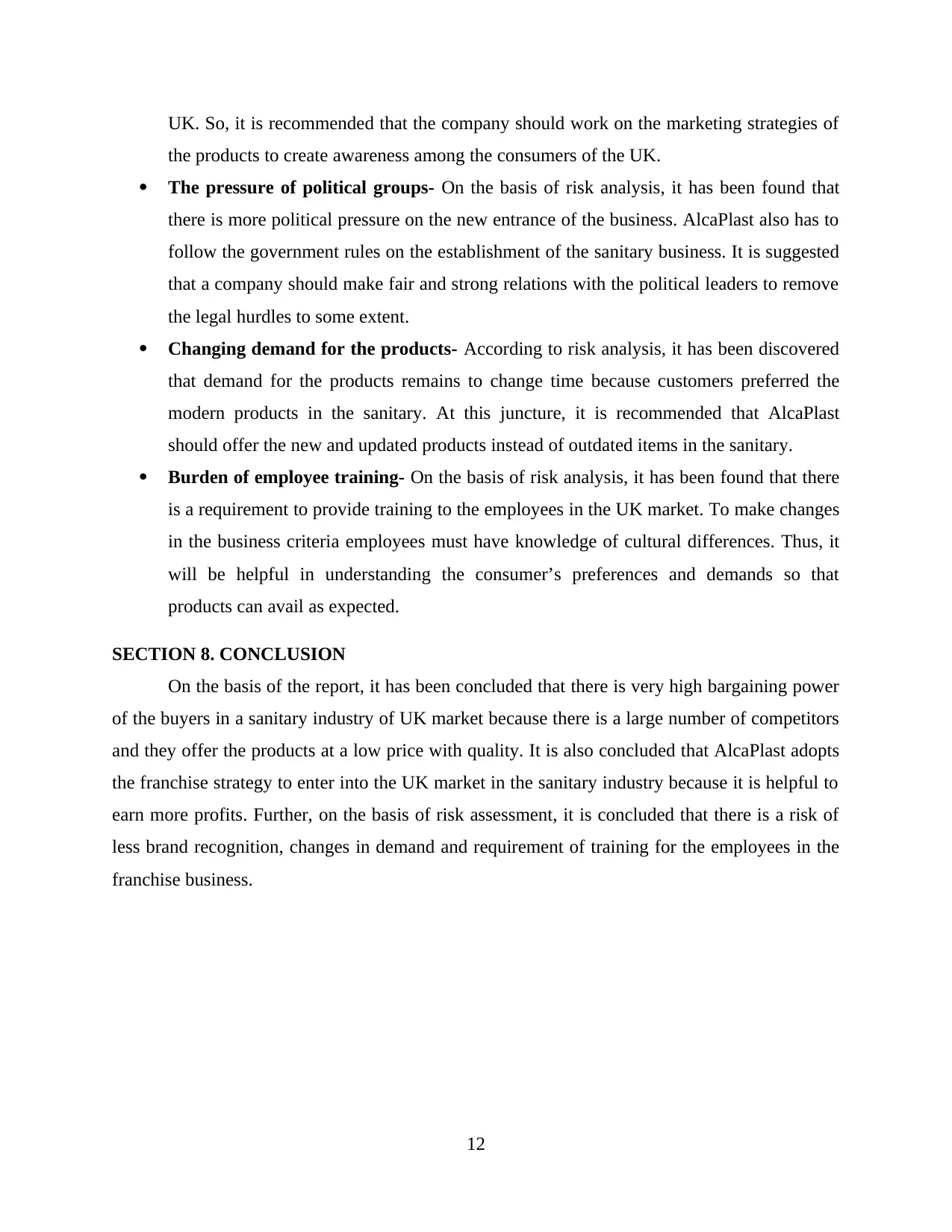
UK. So, it is recommended that the company should work on the marketing strategies of
the products to create awareness among the consumers of the UK.
The pressure of political groups- On the basis of risk analysis, it has been found that
there is more political pressure on the new entrance of the business. AlcaPlast also has to
follow the government rules on the establishment of the sanitary business. It is suggested
that a company should make fair and strong relations with the political leaders to remove
the legal hurdles to some extent.
Changing demand for the products- According to risk analysis, it has been discovered
that demand for the products remains to change time because customers preferred the
modern products in the sanitary. At this juncture, it is recommended that AlcaPlast
should offer the new and updated products instead of outdated items in the sanitary.
Burden of employee training- On the basis of risk analysis, it has been found that there
is a requirement to provide training to the employees in the UK market. To make changes
in the business criteria employees must have knowledge of cultural differences. Thus, it
will be helpful in understanding the consumer’s preferences and demands so that
products can avail as expected.
SECTION 8. CONCLUSION
On the basis of the report, it has been concluded that there is very high bargaining power
of the buyers in a sanitary industry of UK market because there is a large number of competitors
and they offer the products at a low price with quality. It is also concluded that AlcaPlast adopts
the franchise strategy to enter into the UK market in the sanitary industry because it is helpful to
earn more profits. Further, on the basis of risk assessment, it is concluded that there is a risk of
less brand recognition, changes in demand and requirement of training for the employees in the
franchise business.
12
the products to create awareness among the consumers of the UK.
The pressure of political groups- On the basis of risk analysis, it has been found that
there is more political pressure on the new entrance of the business. AlcaPlast also has to
follow the government rules on the establishment of the sanitary business. It is suggested
that a company should make fair and strong relations with the political leaders to remove
the legal hurdles to some extent.
Changing demand for the products- According to risk analysis, it has been discovered
that demand for the products remains to change time because customers preferred the
modern products in the sanitary. At this juncture, it is recommended that AlcaPlast
should offer the new and updated products instead of outdated items in the sanitary.
Burden of employee training- On the basis of risk analysis, it has been found that there
is a requirement to provide training to the employees in the UK market. To make changes
in the business criteria employees must have knowledge of cultural differences. Thus, it
will be helpful in understanding the consumer’s preferences and demands so that
products can avail as expected.
SECTION 8. CONCLUSION
On the basis of the report, it has been concluded that there is very high bargaining power
of the buyers in a sanitary industry of UK market because there is a large number of competitors
and they offer the products at a low price with quality. It is also concluded that AlcaPlast adopts
the franchise strategy to enter into the UK market in the sanitary industry because it is helpful to
earn more profits. Further, on the basis of risk assessment, it is concluded that there is a risk of
less brand recognition, changes in demand and requirement of training for the employees in the
franchise business.
12
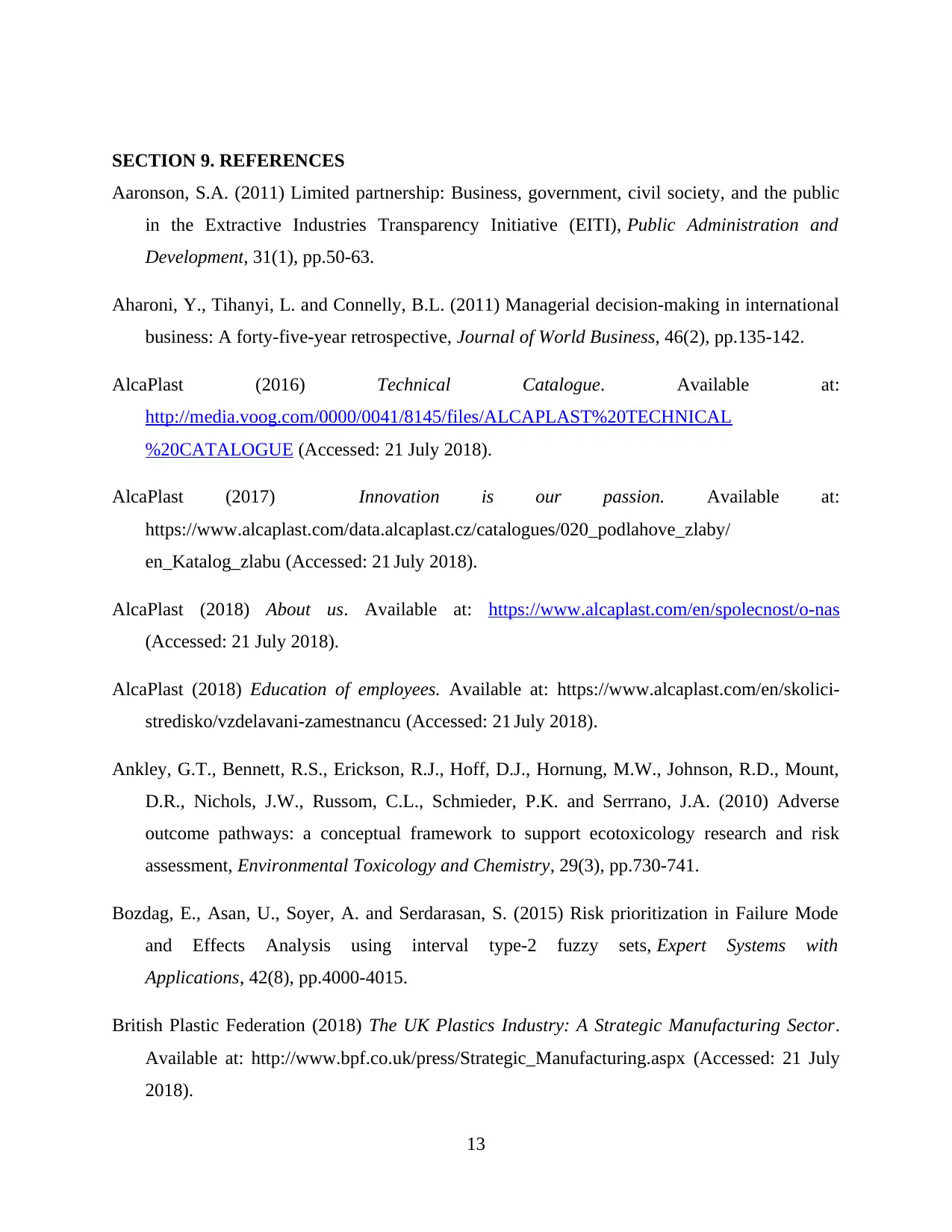
SECTION 9. REFERENCES
Aaronson, S.A. (2011) Limited partnership: Business, government, civil society, and the public
in the Extractive Industries Transparency Initiative (EITI), Public Administration and
Development, 31(1), pp.50-63.
Aharoni, Y., Tihanyi, L. and Connelly, B.L. (2011) Managerial decision-making in international
business: A forty-five-year retrospective, Journal of World Business, 46(2), pp.135-142.
AlcaPlast (2016) Technical Catalogue. Available at:
http://media.voog.com/0000/0041/8145/files/ALCAPLAST%20TECHNICAL
%20CATALOGUE (Accessed: 21 July 2018).
AlcaPlast (2017) Innovation is our passion. Available at:
https://www.alcaplast.com/data.alcaplast.cz/catalogues/020_podlahove_zlaby/
en_Katalog_zlabu (Accessed: 21 July 2018).
AlcaPlast (2018) About us. Available at: https://www.alcaplast.com/en/spolecnost/o-nas
(Accessed: 21 July 2018).
AlcaPlast (2018) Education of employees. Available at: https://www.alcaplast.com/en/skolici-
stredisko/vzdelavani-zamestnancu (Accessed: 21 July 2018).
Ankley, G.T., Bennett, R.S., Erickson, R.J., Hoff, D.J., Hornung, M.W., Johnson, R.D., Mount,
D.R., Nichols, J.W., Russom, C.L., Schmieder, P.K. and Serrrano, J.A. (2010) Adverse
outcome pathways: a conceptual framework to support ecotoxicology research and risk
assessment, Environmental Toxicology and Chemistry, 29(3), pp.730-741.
Bozdag, E., Asan, U., Soyer, A. and Serdarasan, S. (2015) Risk prioritization in Failure Mode
and Effects Analysis using interval type-2 fuzzy sets, Expert Systems with
Applications, 42(8), pp.4000-4015.
British Plastic Federation (2018) The UK Plastics Industry: A Strategic Manufacturing Sector.
Available at: http://www.bpf.co.uk/press/Strategic_Manufacturing.aspx (Accessed: 21 July
2018).
13
Aaronson, S.A. (2011) Limited partnership: Business, government, civil society, and the public
in the Extractive Industries Transparency Initiative (EITI), Public Administration and
Development, 31(1), pp.50-63.
Aharoni, Y., Tihanyi, L. and Connelly, B.L. (2011) Managerial decision-making in international
business: A forty-five-year retrospective, Journal of World Business, 46(2), pp.135-142.
AlcaPlast (2016) Technical Catalogue. Available at:
http://media.voog.com/0000/0041/8145/files/ALCAPLAST%20TECHNICAL
%20CATALOGUE (Accessed: 21 July 2018).
AlcaPlast (2017) Innovation is our passion. Available at:
https://www.alcaplast.com/data.alcaplast.cz/catalogues/020_podlahove_zlaby/
en_Katalog_zlabu (Accessed: 21 July 2018).
AlcaPlast (2018) About us. Available at: https://www.alcaplast.com/en/spolecnost/o-nas
(Accessed: 21 July 2018).
AlcaPlast (2018) Education of employees. Available at: https://www.alcaplast.com/en/skolici-
stredisko/vzdelavani-zamestnancu (Accessed: 21 July 2018).
Ankley, G.T., Bennett, R.S., Erickson, R.J., Hoff, D.J., Hornung, M.W., Johnson, R.D., Mount,
D.R., Nichols, J.W., Russom, C.L., Schmieder, P.K. and Serrrano, J.A. (2010) Adverse
outcome pathways: a conceptual framework to support ecotoxicology research and risk
assessment, Environmental Toxicology and Chemistry, 29(3), pp.730-741.
Bozdag, E., Asan, U., Soyer, A. and Serdarasan, S. (2015) Risk prioritization in Failure Mode
and Effects Analysis using interval type-2 fuzzy sets, Expert Systems with
Applications, 42(8), pp.4000-4015.
British Plastic Federation (2018) The UK Plastics Industry: A Strategic Manufacturing Sector.
Available at: http://www.bpf.co.uk/press/Strategic_Manufacturing.aspx (Accessed: 21 July
2018).
13
Secure Best Marks with AI Grader
Need help grading? Try our AI Grader for instant feedback on your assignments.
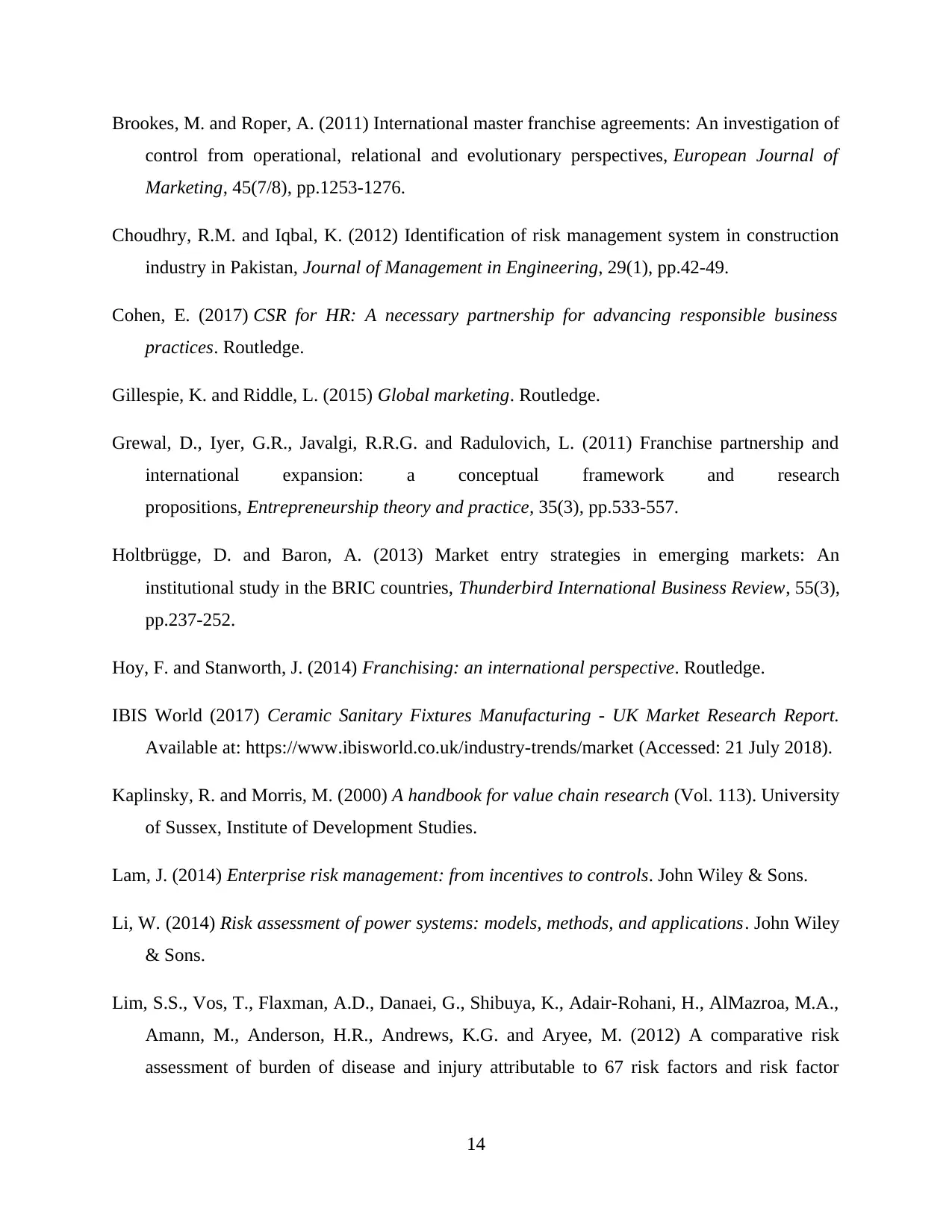
Brookes, M. and Roper, A. (2011) International master franchise agreements: An investigation of
control from operational, relational and evolutionary perspectives, European Journal of
Marketing, 45(7/8), pp.1253-1276.
Choudhry, R.M. and Iqbal, K. (2012) Identification of risk management system in construction
industry in Pakistan, Journal of Management in Engineering, 29(1), pp.42-49.
Cohen, E. (2017) CSR for HR: A necessary partnership for advancing responsible business
practices. Routledge.
Gillespie, K. and Riddle, L. (2015) Global marketing. Routledge.
Grewal, D., Iyer, G.R., Javalgi, R.R.G. and Radulovich, L. (2011) Franchise partnership and
international expansion: a conceptual framework and research
propositions, Entrepreneurship theory and practice, 35(3), pp.533-557.
Holtbrügge, D. and Baron, A. (2013) Market entry strategies in emerging markets: An
institutional study in the BRIC countries, Thunderbird International Business Review, 55(3),
pp.237-252.
Hoy, F. and Stanworth, J. (2014) Franchising: an international perspective. Routledge.
IBIS World (2017) Ceramic Sanitary Fixtures Manufacturing - UK Market Research Report.
Available at: https://www.ibisworld.co.uk/industry-trends/market (Accessed: 21 July 2018).
Kaplinsky, R. and Morris, M. (2000) A handbook for value chain research (Vol. 113). University
of Sussex, Institute of Development Studies.
Lam, J. (2014) Enterprise risk management: from incentives to controls. John Wiley & Sons.
Li, W. (2014) Risk assessment of power systems: models, methods, and applications. John Wiley
& Sons.
Lim, S.S., Vos, T., Flaxman, A.D., Danaei, G., Shibuya, K., Adair-Rohani, H., AlMazroa, M.A.,
Amann, M., Anderson, H.R., Andrews, K.G. and Aryee, M. (2012) A comparative risk
assessment of burden of disease and injury attributable to 67 risk factors and risk factor
14
control from operational, relational and evolutionary perspectives, European Journal of
Marketing, 45(7/8), pp.1253-1276.
Choudhry, R.M. and Iqbal, K. (2012) Identification of risk management system in construction
industry in Pakistan, Journal of Management in Engineering, 29(1), pp.42-49.
Cohen, E. (2017) CSR for HR: A necessary partnership for advancing responsible business
practices. Routledge.
Gillespie, K. and Riddle, L. (2015) Global marketing. Routledge.
Grewal, D., Iyer, G.R., Javalgi, R.R.G. and Radulovich, L. (2011) Franchise partnership and
international expansion: a conceptual framework and research
propositions, Entrepreneurship theory and practice, 35(3), pp.533-557.
Holtbrügge, D. and Baron, A. (2013) Market entry strategies in emerging markets: An
institutional study in the BRIC countries, Thunderbird International Business Review, 55(3),
pp.237-252.
Hoy, F. and Stanworth, J. (2014) Franchising: an international perspective. Routledge.
IBIS World (2017) Ceramic Sanitary Fixtures Manufacturing - UK Market Research Report.
Available at: https://www.ibisworld.co.uk/industry-trends/market (Accessed: 21 July 2018).
Kaplinsky, R. and Morris, M. (2000) A handbook for value chain research (Vol. 113). University
of Sussex, Institute of Development Studies.
Lam, J. (2014) Enterprise risk management: from incentives to controls. John Wiley & Sons.
Li, W. (2014) Risk assessment of power systems: models, methods, and applications. John Wiley
& Sons.
Lim, S.S., Vos, T., Flaxman, A.D., Danaei, G., Shibuya, K., Adair-Rohani, H., AlMazroa, M.A.,
Amann, M., Anderson, H.R., Andrews, K.G. and Aryee, M. (2012) A comparative risk
assessment of burden of disease and injury attributable to 67 risk factors and risk factor
14
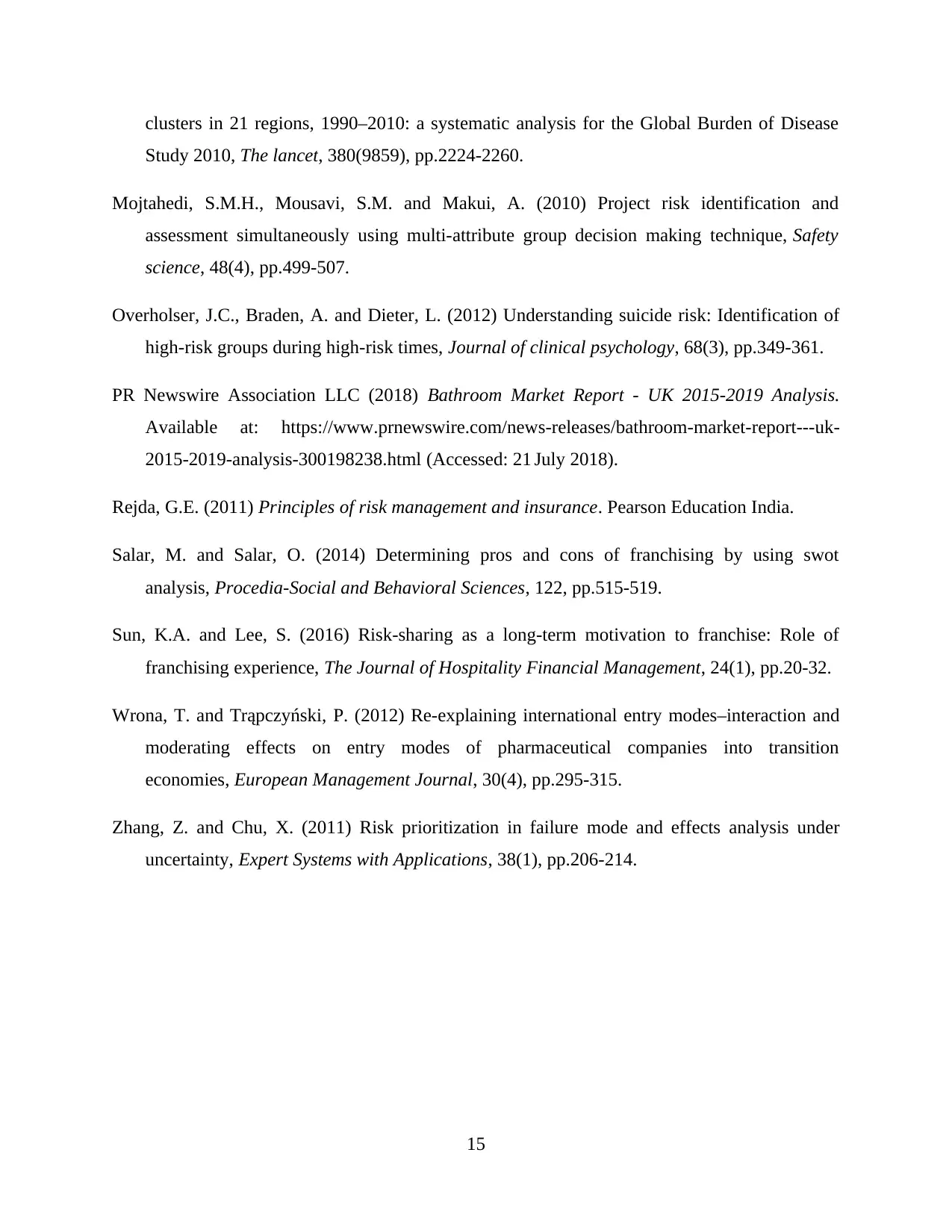
clusters in 21 regions, 1990–2010: a systematic analysis for the Global Burden of Disease
Study 2010, The lancet, 380(9859), pp.2224-2260.
Mojtahedi, S.M.H., Mousavi, S.M. and Makui, A. (2010) Project risk identification and
assessment simultaneously using multi-attribute group decision making technique, Safety
science, 48(4), pp.499-507.
Overholser, J.C., Braden, A. and Dieter, L. (2012) Understanding suicide risk: Identification of
high‐risk groups during high‐risk times, Journal of clinical psychology, 68(3), pp.349-361.
PR Newswire Association LLC (2018) Bathroom Market Report - UK 2015-2019 Analysis.
Available at: https://www.prnewswire.com/news-releases/bathroom-market-report---uk-
2015-2019-analysis-300198238.html (Accessed: 21 July 2018).
Rejda, G.E. (2011) Principles of risk management and insurance. Pearson Education India.
Salar, M. and Salar, O. (2014) Determining pros and cons of franchising by using swot
analysis, Procedia-Social and Behavioral Sciences, 122, pp.515-519.
Sun, K.A. and Lee, S. (2016) Risk-sharing as a long-term motivation to franchise: Role of
franchising experience, The Journal of Hospitality Financial Management, 24(1), pp.20-32.
Wrona, T. and Trąpczyński, P. (2012) Re-explaining international entry modes–interaction and
moderating effects on entry modes of pharmaceutical companies into transition
economies, European Management Journal, 30(4), pp.295-315.
Zhang, Z. and Chu, X. (2011) Risk prioritization in failure mode and effects analysis under
uncertainty, Expert Systems with Applications, 38(1), pp.206-214.
15
Study 2010, The lancet, 380(9859), pp.2224-2260.
Mojtahedi, S.M.H., Mousavi, S.M. and Makui, A. (2010) Project risk identification and
assessment simultaneously using multi-attribute group decision making technique, Safety
science, 48(4), pp.499-507.
Overholser, J.C., Braden, A. and Dieter, L. (2012) Understanding suicide risk: Identification of
high‐risk groups during high‐risk times, Journal of clinical psychology, 68(3), pp.349-361.
PR Newswire Association LLC (2018) Bathroom Market Report - UK 2015-2019 Analysis.
Available at: https://www.prnewswire.com/news-releases/bathroom-market-report---uk-
2015-2019-analysis-300198238.html (Accessed: 21 July 2018).
Rejda, G.E. (2011) Principles of risk management and insurance. Pearson Education India.
Salar, M. and Salar, O. (2014) Determining pros and cons of franchising by using swot
analysis, Procedia-Social and Behavioral Sciences, 122, pp.515-519.
Sun, K.A. and Lee, S. (2016) Risk-sharing as a long-term motivation to franchise: Role of
franchising experience, The Journal of Hospitality Financial Management, 24(1), pp.20-32.
Wrona, T. and Trąpczyński, P. (2012) Re-explaining international entry modes–interaction and
moderating effects on entry modes of pharmaceutical companies into transition
economies, European Management Journal, 30(4), pp.295-315.
Zhang, Z. and Chu, X. (2011) Risk prioritization in failure mode and effects analysis under
uncertainty, Expert Systems with Applications, 38(1), pp.206-214.
15
1 out of 18
Related Documents
Your All-in-One AI-Powered Toolkit for Academic Success.
+13062052269
info@desklib.com
Available 24*7 on WhatsApp / Email
![[object Object]](/_next/static/media/star-bottom.7253800d.svg)
Unlock your academic potential
© 2024 | Zucol Services PVT LTD | All rights reserved.





